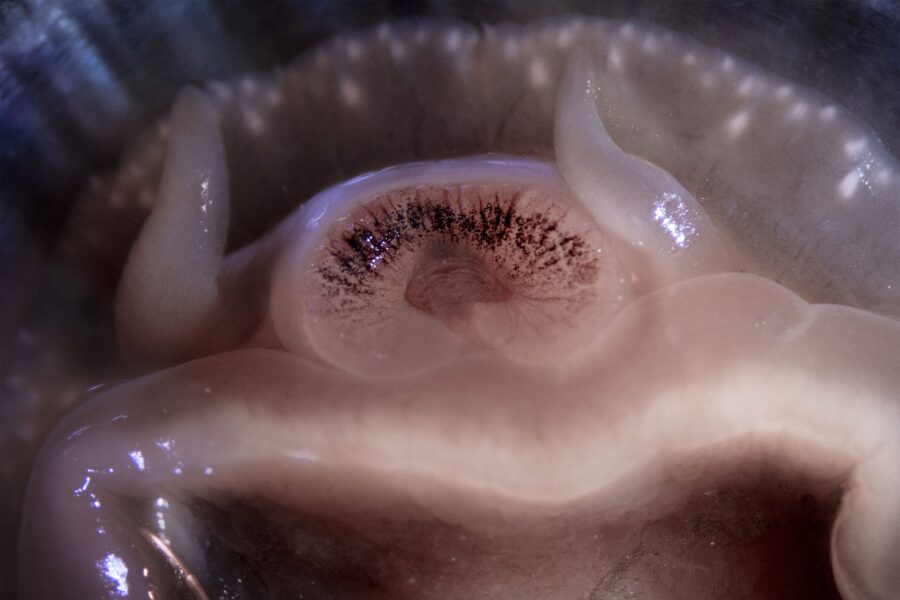In an essay called Slick Images, artist and researcher Susan Schuppli suggests we have now entered “a new geo-photo-graphic era in which planetary systems have been transformed into vast photosensitive arrays that are registering and recording the rapid transformations induced by modern industrialization and its contaminating processes.”1
As theorized by Susan Schuppli, matter — and by extension territories and places – has the capacity to record and reveal the image of its own contamination as a “material witness”.2 The notion of “material witnesses” is useful to understand many contemporary artistic practices that actively seek ways to incorporate non-human agencies into their work, in order to investigate the consequences of industrialization and capitalism in a non anthropocentric perspective.
In chemistry, toxicity is the degree to which a chemical substance can cause damage to an organism: this effect is dose-dependent, and species-specific. There is then an intrinsic ambivalence in a toxic element that depending on the dose can be a remedy or a poison, and its capacity to harm one organism while benefiting another.
Acknowledging that both organic and inorganic entities are equipped with a toxic agency means recognising that pollution also activates the ability of living forms to evolve and mutate, reconfiguring the hierarchies of power in the relationship between human and non-human, polluters and pollutants.
What are then the effects of contamination within us, inside us, on our relationships with other life forms? If we agree with Donna Haraway’s proposition that all vision has an embodied nature,3 how can we integrate the toxicity of the world into the very material of the image?
The works presented here blur the boundaries between image, plant, animal and landscape. The toxins that infest our habitat become a departure point for weaving and defining new relationships. These images are above all a powerful testimony to the resilience and survival of intoxicated forms of life, and to the artists’ will to endlessly seek forms of representations that reflect on these contaminations.
moss collective
Lieselotte Egtberts, Elisa Maupas, Lucie Ménard, Anna Stoppa
1 Schuppli, Susan. “Slick Images: The Photogenic Surface of Disaster.” (2015).
2 Schuppli, Susan. “Material Witness: Media, Forensics, Evidence.” (2020).
3 Haraway, D. “1988: Situated knowledges: the science question in feminism and the privilege of partial perspective.
Feminist Studies 14, 575-99.” (1988)
Algues maudites • Alice Pallot
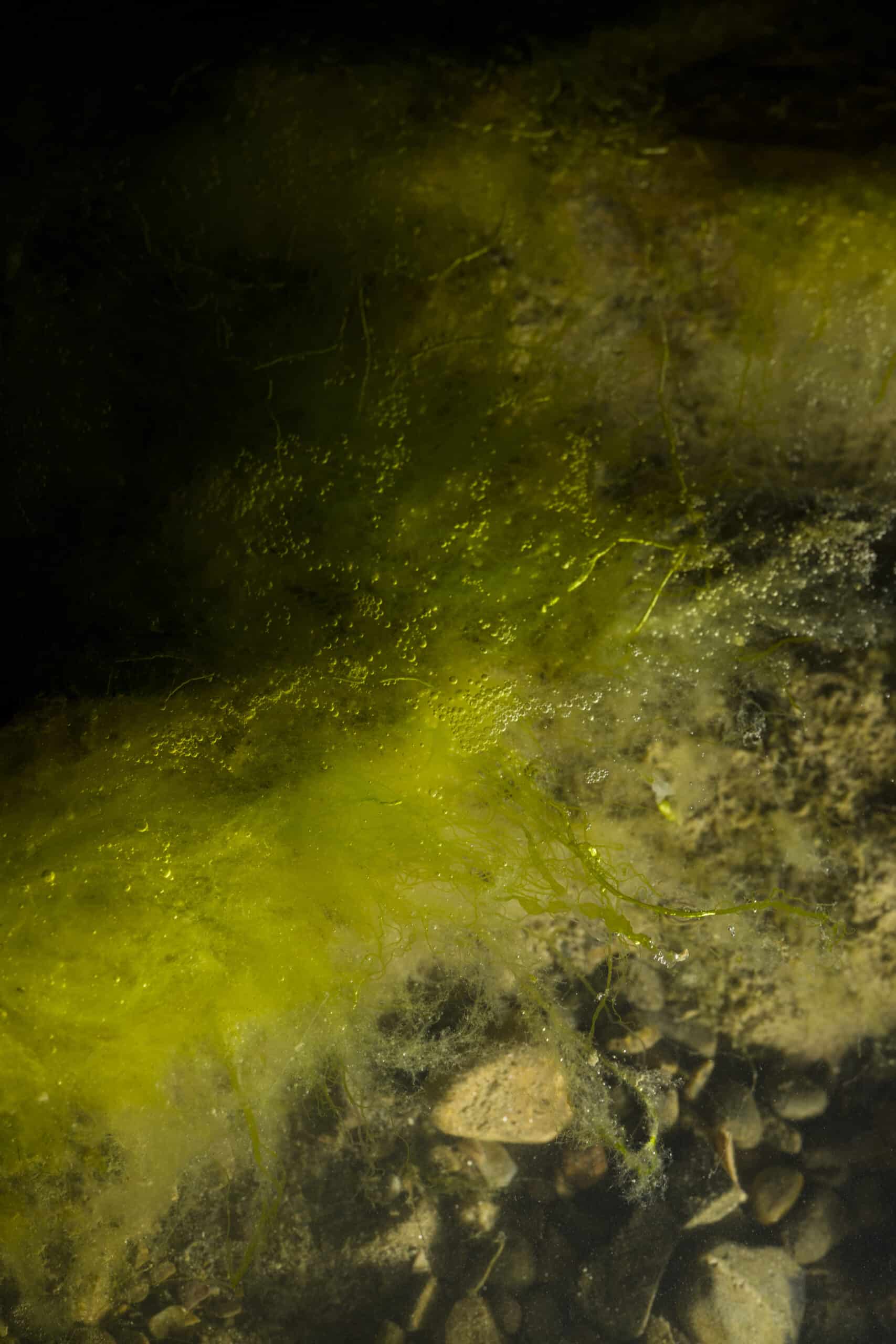
Algues vertes, mai 2022. Project made during the residency 1+2,
in collaboration with Centre Wallonie-Bruxelles. In recent years, the disposal of waste from pigs farming - which is especially rich in nitrates and phosphate - has been accelerating the propagation of seaweed, currently infesting several kilometers of shores in Brittany. The algae are not toxic per se, but one of the by-products of its decay is hydrogen sulfide, a gas that is lethal for men and animals.
Alice Pallot describes her approach in Algues Maudites (Cursed Algae), as a practice of “sensitive documentary”. Anchored in rigorous scientific research at CNRS Occitanie Ouest, her work deviates from pure documentary and incorporates fictional narratives. This is a tool that the artist employs to seize the truth of her subject: the phenomenon of poisonous algae washing up en masse on the Brittany shores.
An issue twice invisible: on an environmental scale, since the gas released by these algae decomposing on the beach is imperceptible, yet lethal for humans and animals; and on a social scale, given the local authorities’ attempts to hide the true extent of the problem.
The notion of toxicity unlocks the different entanglements between humans and ‘cursed algae’. The seaweed is an organism that is not at all dangerous in its own marine habitat, it is only due to the impact of local agricultural activities that its excessive propagation becomes a threat. This project thus underlines the fact that toxicity is above all a matter of dosage and context.
Here, Alice Pallot takes the chance to approach the toxicant with empathy, and invites it to participate in the photographic process in various capacities: as subject, as filter, as colorant, as substrate.
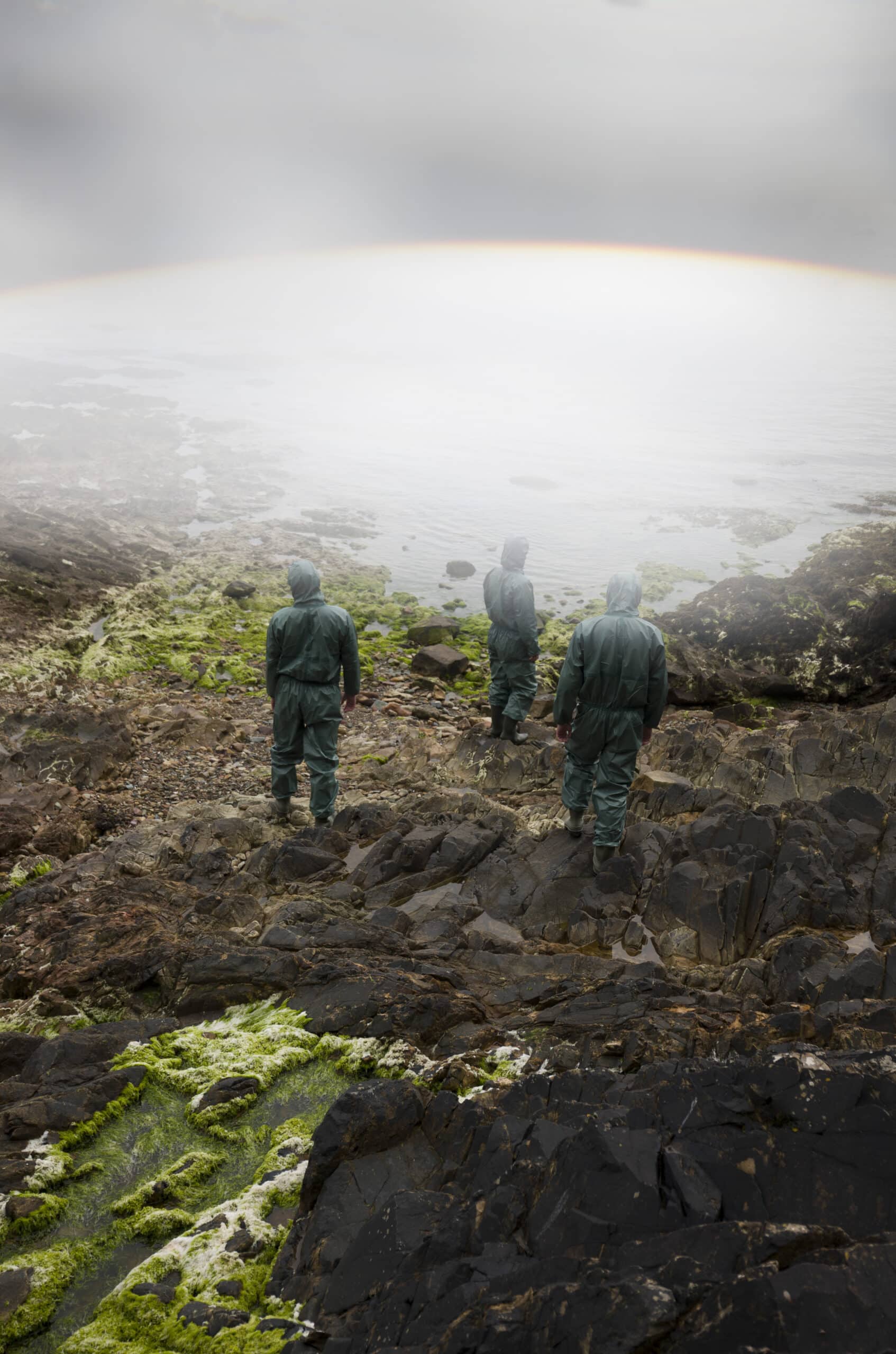
Alice Pallot, Algues maudites, 2022.
Mission vérité terrain, juin 2022. Project made during the residency 1+2, in collaboration with Centre Wallonie-Bruxelles.
Alice Pallot photographs the now lifeless expanses of shores affected by the ‘cursed algae’ phenomena. “Green tides are the new oil tides” in the words of one of the ecologists she met, Yves-Marie le Lay from Sauvegarde du Trégor. Under the compact layer of dry algae, there is now black sand suffocated by the lack of oxygen. This image is a staged reinterpretation of a ground truth mission conducted by scientists, which the artist was not allowed to document. Fictionalizing truth is not for a contradiction within the documentary status of the series, but, on the contrary, this staged image highlights the intentional invisibilization of the ‘cursed algae’ phenomena by the local authorities.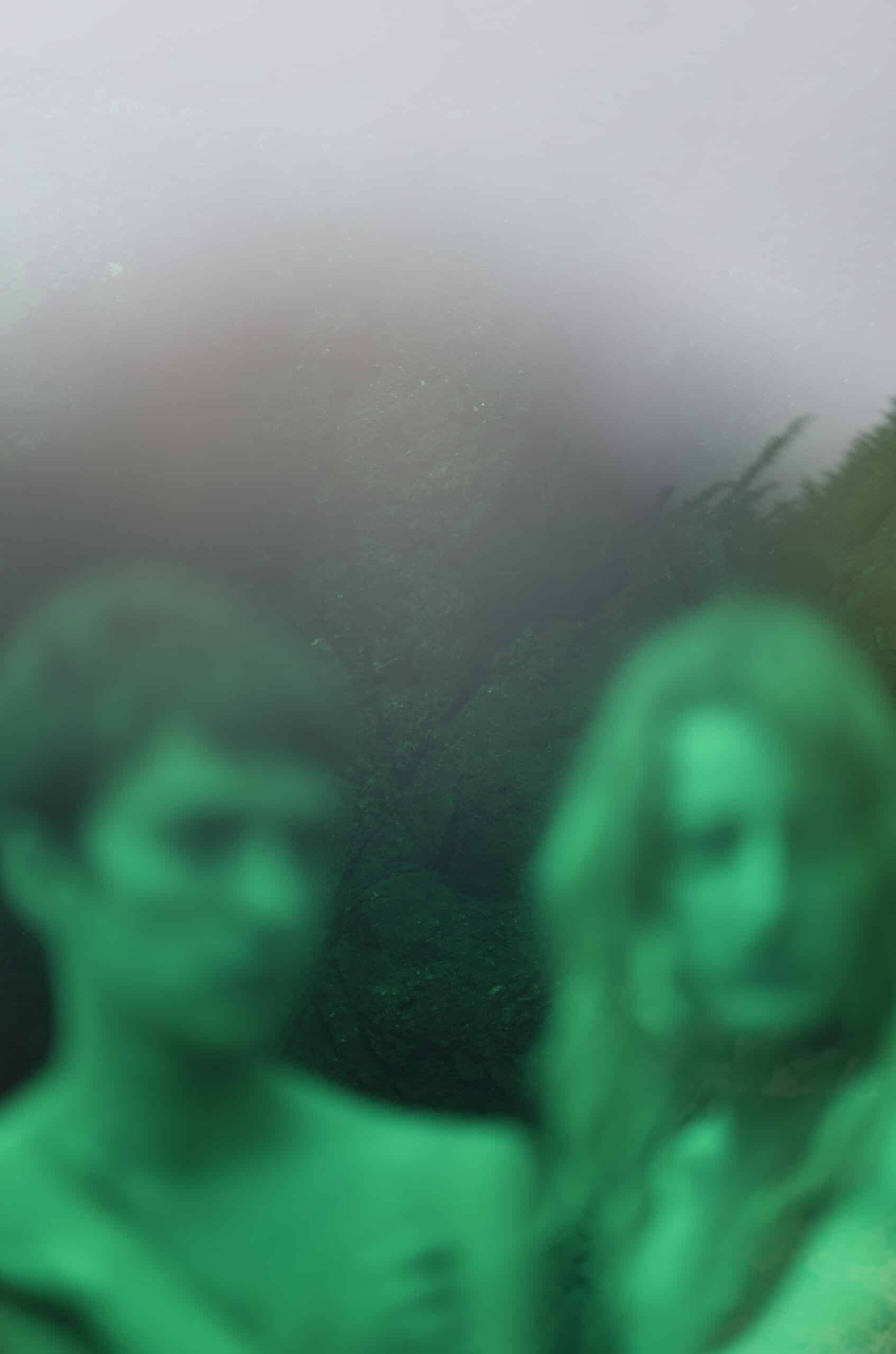
Alice Pallot, Algues maudites, 2022.
Visages verts, juin 2022.
Wishing to incorporate the toxicity of the dead beaches into the images, Alice Pallot decided to shoot through translucent objects collected on the beach: here, sheets of toxic algae blur the faces of the characters watching us. The algae are incorporated into the photographic process itself, no longer mere subjects, become optical filters to observe the humans inhabiting these toxic spaces.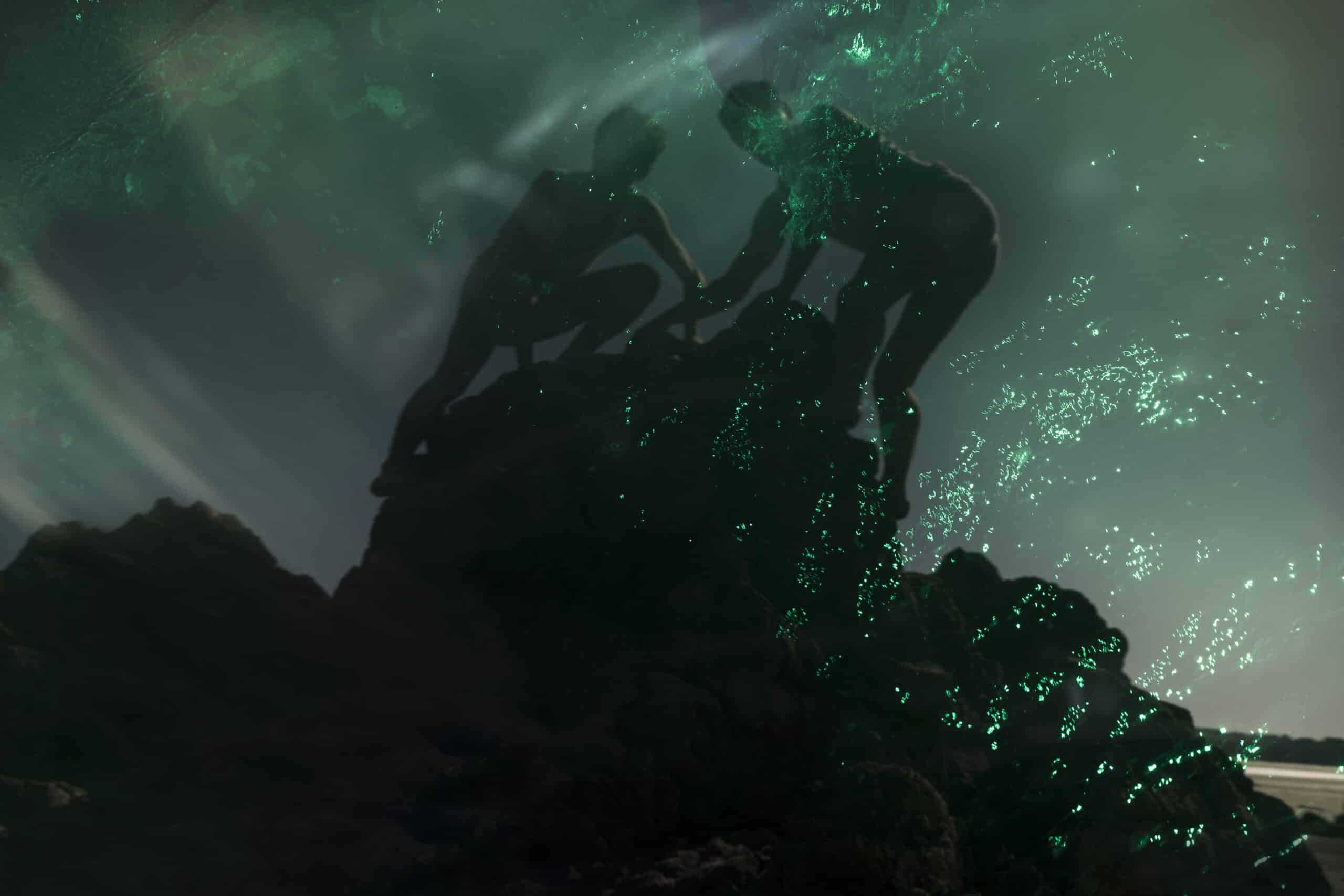
Alice Pallot, Algues maudites, 2022.
Marées vertes, juin 2022.
This low-angle image reverses the perspective towards the agency of non humans, evoking the point of view of algae observing humans. Here, Alice Pallot employs a discarded plastic bottle as an optical filter, another element referring to the ubiquitous pollution of beaches in Brittany and elsewhere.

Alice Pallot, Algues maudites, 2022.
Plage déchue, cyanobacteries, juin 2022.
During an experiment carried out with scientists from the CNRS Occitanie Ouest in Toulouse, Alice Pallot grew microalgae (cyanobacteria Phormidium autumnale) over archival images documenting the pollution of Bittany shores. Here, an archival aerial view of a beach is partially obliterated by the propagating microalgae.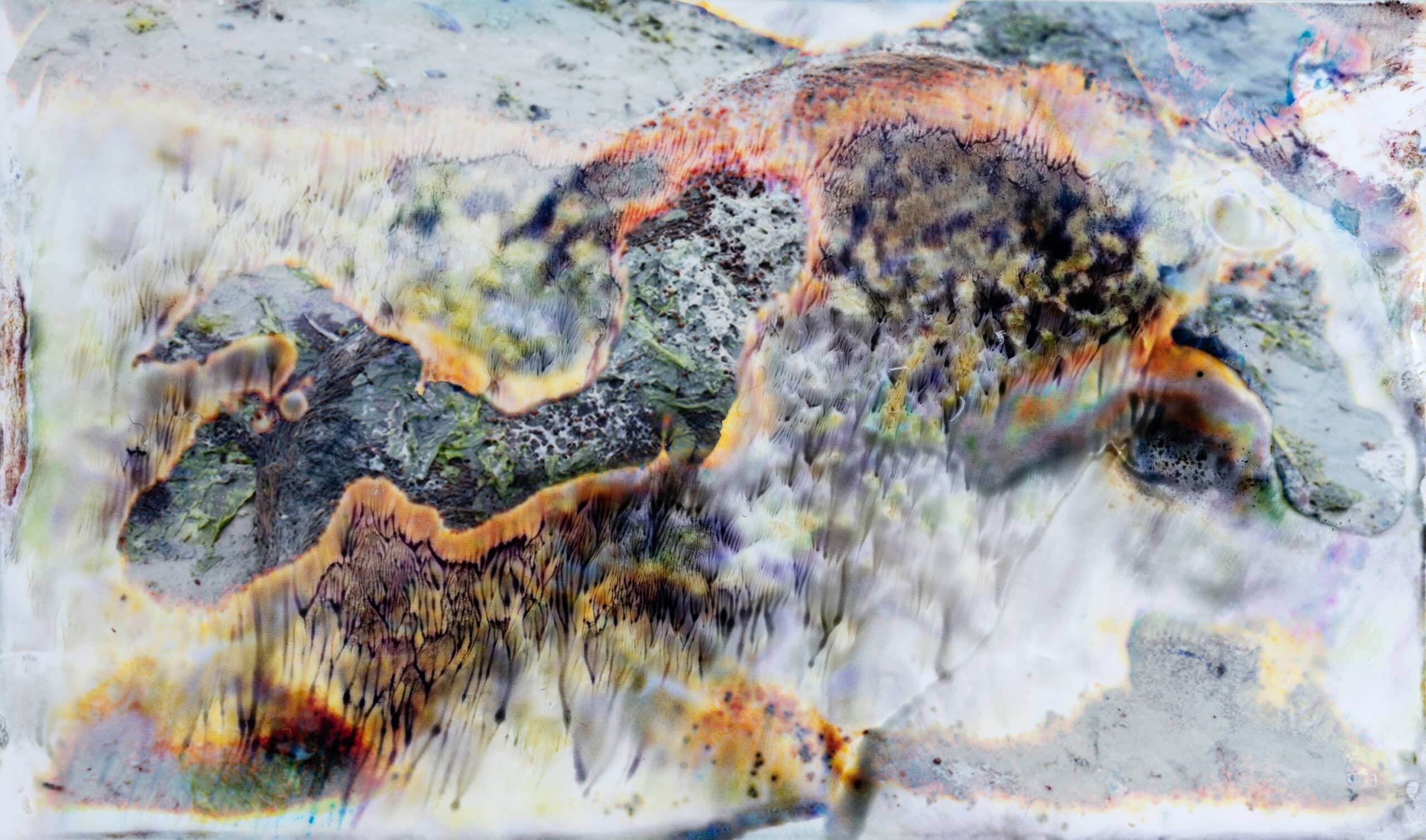
Alice Pallot, Algues maudites, 2022.
Marcassin hybride, cyanobactéries, juin 2022.
Also from the archives, this image represents a dead boar, asphyxiated by the gas released by the decaying algae. The print was immersed for a month in a petri dish, and upon retrieval, Alice Pallot observed that the chemical burn degraded the original image into abstraction.
Vivants • Matthieu Gafsou
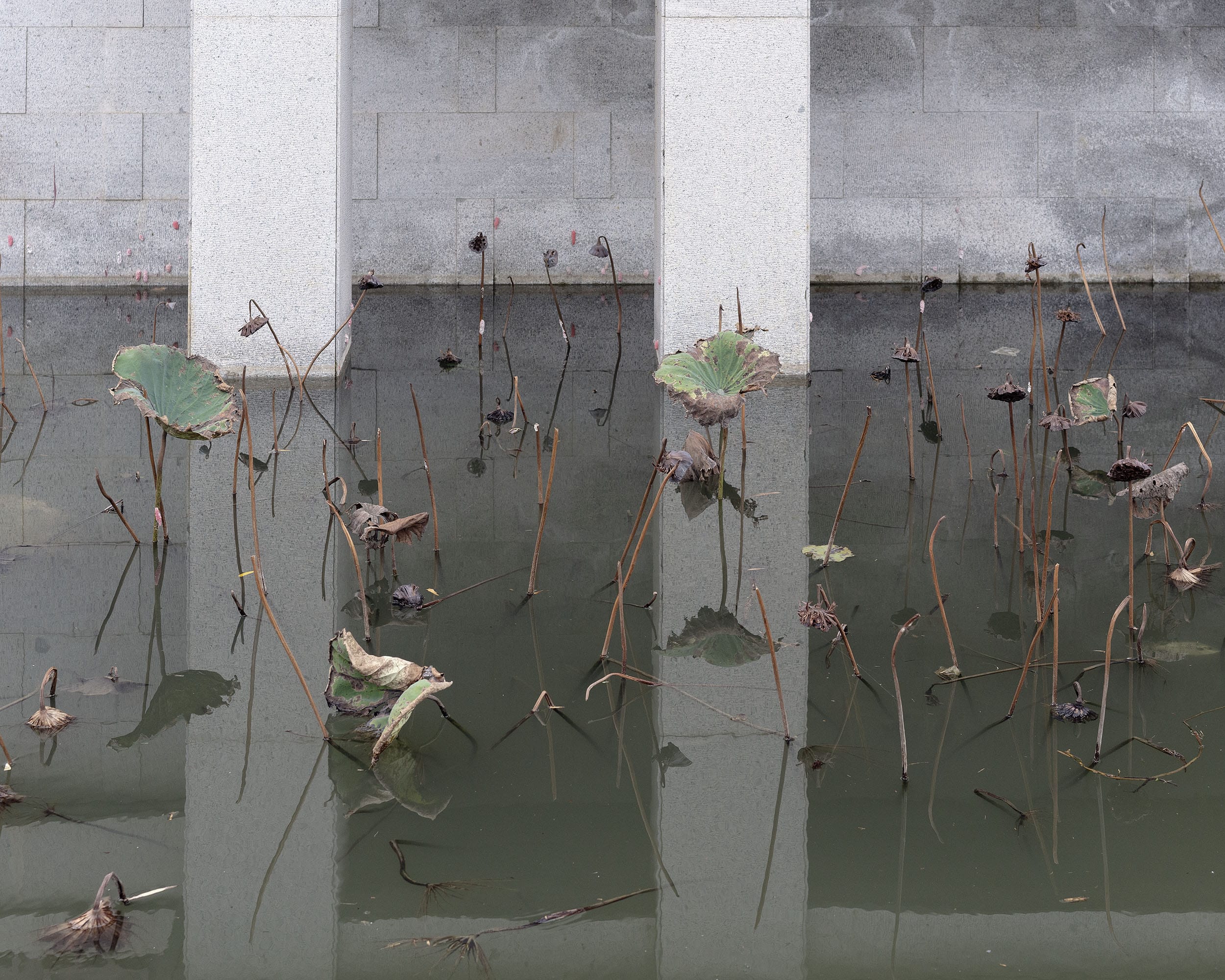
Vivants by Matthieu Gafsou evokes the feeling of solastalgia, a neologism by philosopher Glenn Albrecht that describes the pain caused by the loss of a natural habitat, the ache one feels when realizing that the place where one belongs is inevitably deteriorated.
Vivants by Matthieu Gafsou aims to render perceptible the invisible toxicity pervading our habitats. Treating the surface of the photographs with crude oil to alter the image with false colors, and staging interventions with harmless pollutants in the natural space, he reflects on the sensory appeal of the contaminated landscape.
The project questions human responsibility towards the loss of biodiversity and environmental changes, and our inability to grasp the scale of the destruction unraveling in front of us.
Matthieu Gafsou renders an unsettling image of the places we inhabit, as if they were observed by a non-human gaze that alone is able to perceive their latent toxicity. As if the pollutant were observing our world and perceiving us humans as
the contaminant agent.

Matthieu Gafsou, Vivants (2018-2022), Pétrole IX, 2020. Pigment print with oil, digitalised.
The images in the series “Pétrole” are subjected to a particular physical treatment, a process that aims to function as a visual metaphor for the pervasiveness of toxicity in our habitats - whether it’s air, water, land or light pollution. Matthieu Gafsou applies crude oil to the entire surface of the prints as a pigment, directly altering the original colors of the landscapes in the photographs, resulting in iridescent false colors that highlight the invisible contamination.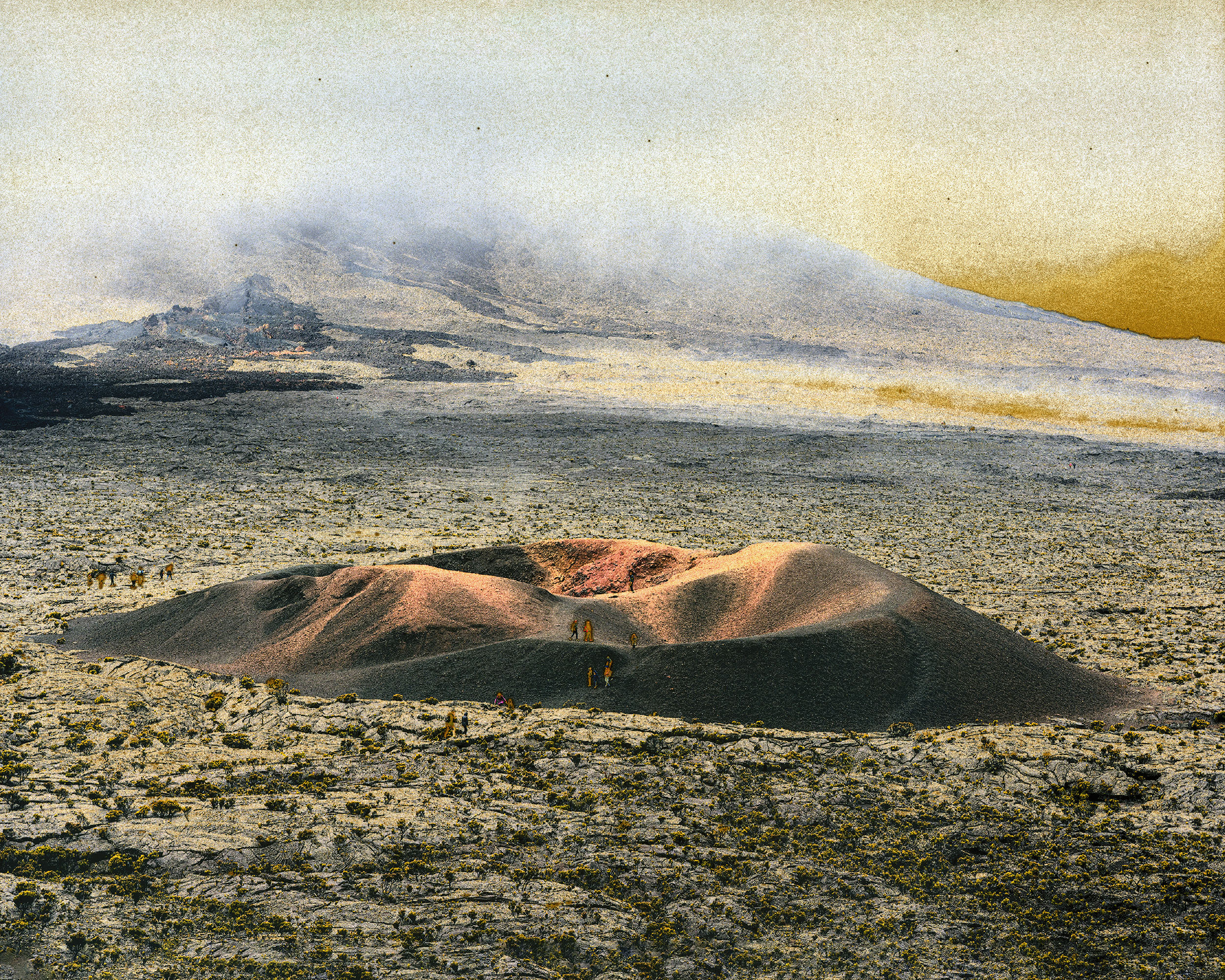
Matthieu Gafsou, Vivants (2018-2022), Pétrole III, 2022. Pigment print with oil, digitalised.
The images treated with crude oil render a metaphorical visualization of the pollution, like an infrared image, as observed by a non-human gaze able to perceive the latent contamination of these territories. Almost like a perception of our human world from the perspective of the pollutant.
“What I really like about this crude oil technique is that in certain respects it is similar to the old photographic technique called toning, that uses chemical elements (historically gold, copper, selenium) to dye the print. However, the unpredictable visual effect produced by tinting with crude oil, to me seems to translate quite well the consequences of oil exploitation on our environment: namely a contamination that is not localized, but global.”
Matthieu Gafsou, Vivants (2018-2022), Feu I, 2019. Pigment print.
Without concealing the degradation of natural environments, Vivants is above all a celebration of the living, an hopeful ode to its beauty and resilience.
“The distress and the dread that can emerge from the seemingly trivial scenes I have photographed refer to the sublime, resurrecting this destructive force of nature that in the 19th century we sought conquering in the mountains or the oceans.”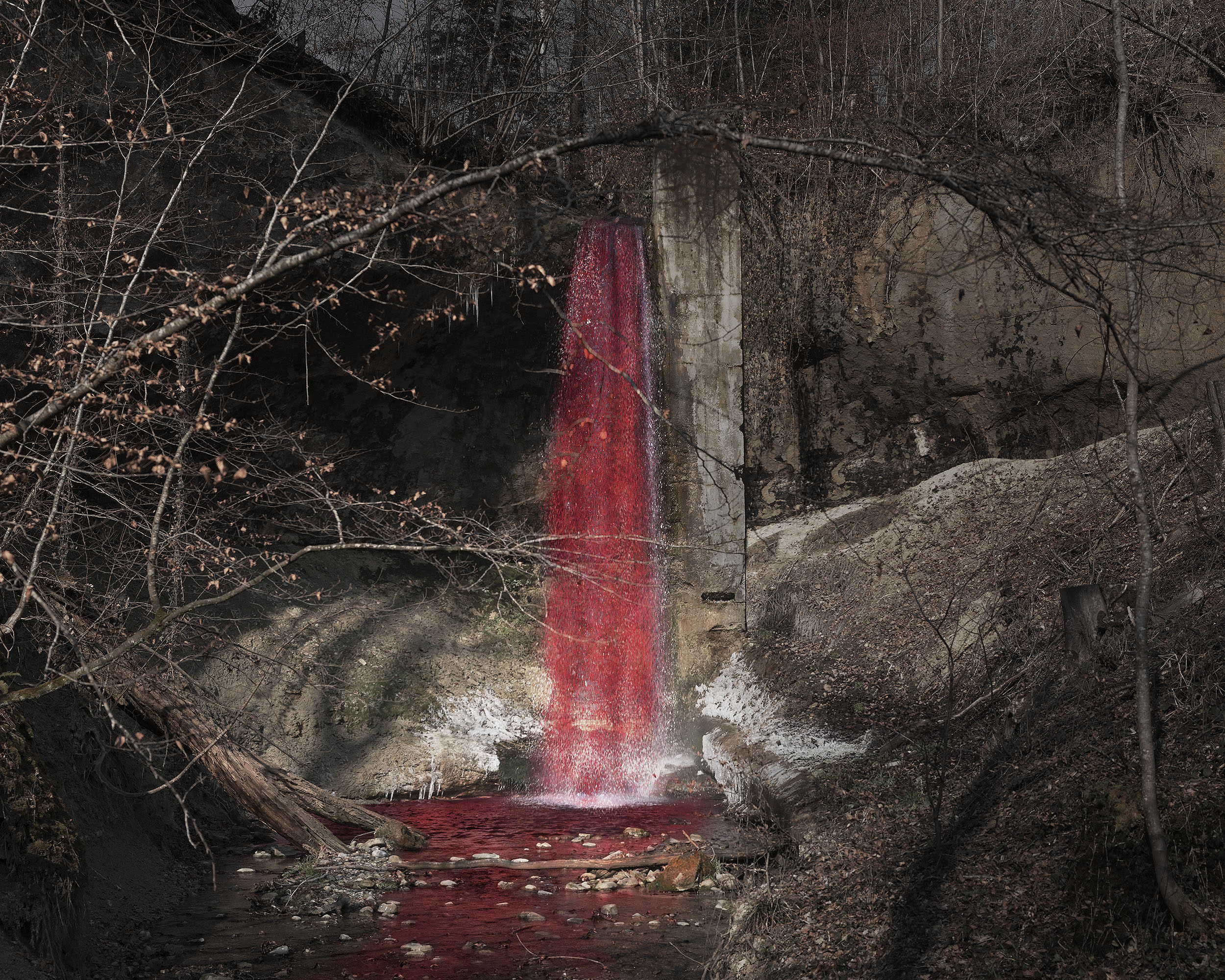
Matthieu Gafsou, Vivants (2018-2022). Plaie I, 2022. Pigment print.
For another set of images in “Vivants”, Matthieu Gafsou stages intervention with harmless contaminants in the landscape. Here, the striking appearance of a red waterfall surrounded by trees is obtained by adding a natural beet dye to the water stream.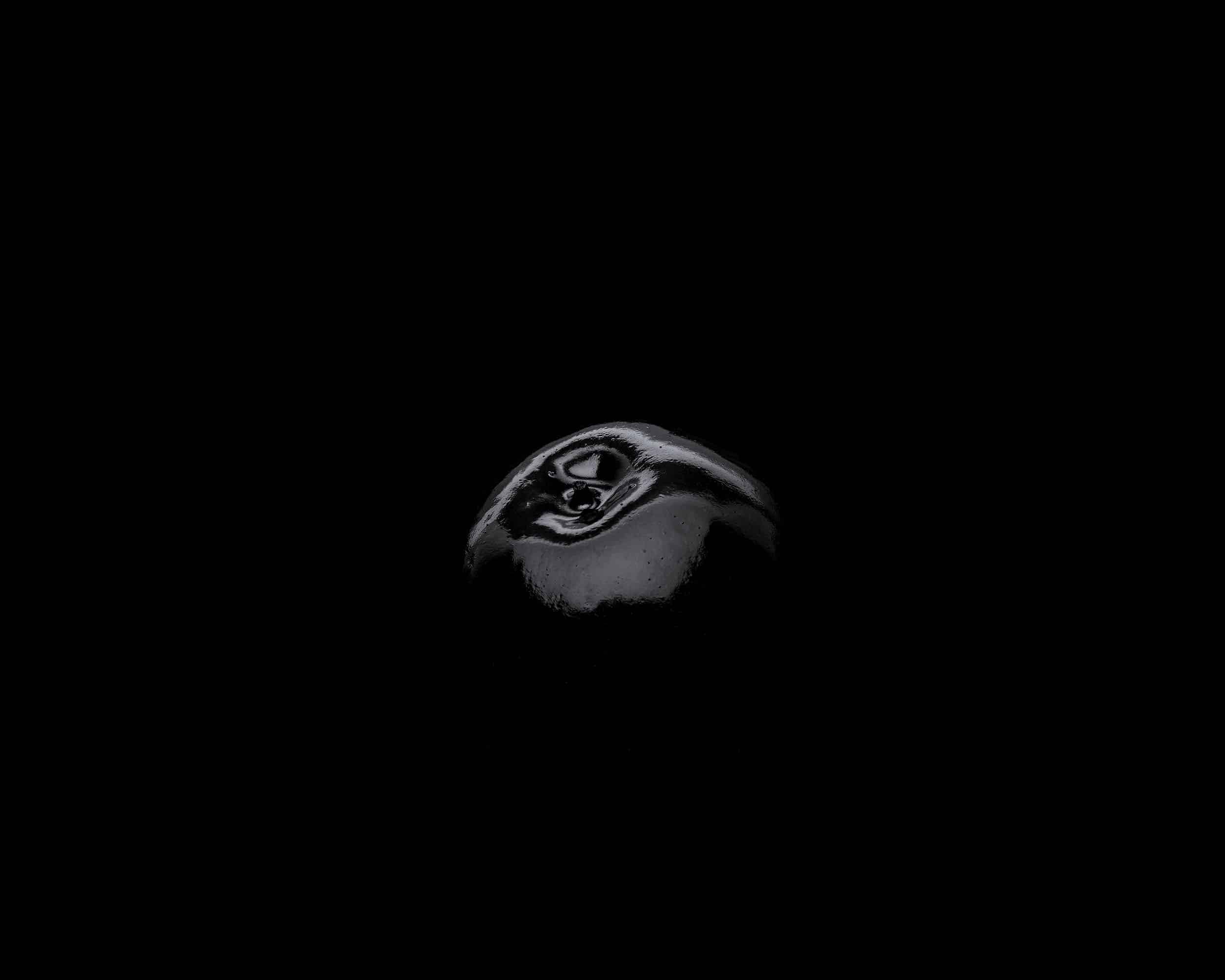
Matthieu Gafsou, Vivants (2018-2022). Fruit I, 2020. Pigment print.
An apple is covered in black bitumen: a still life, evoking oil spills, and a luscious fruit shining like a jewel, attractive yet toxic. Perhaps conjuring the apple of knowledge from Genesis, or the poisoned apple of Snow White, equally as tempting as it is dangerous?
Zilverbeek • Lucas Leffler
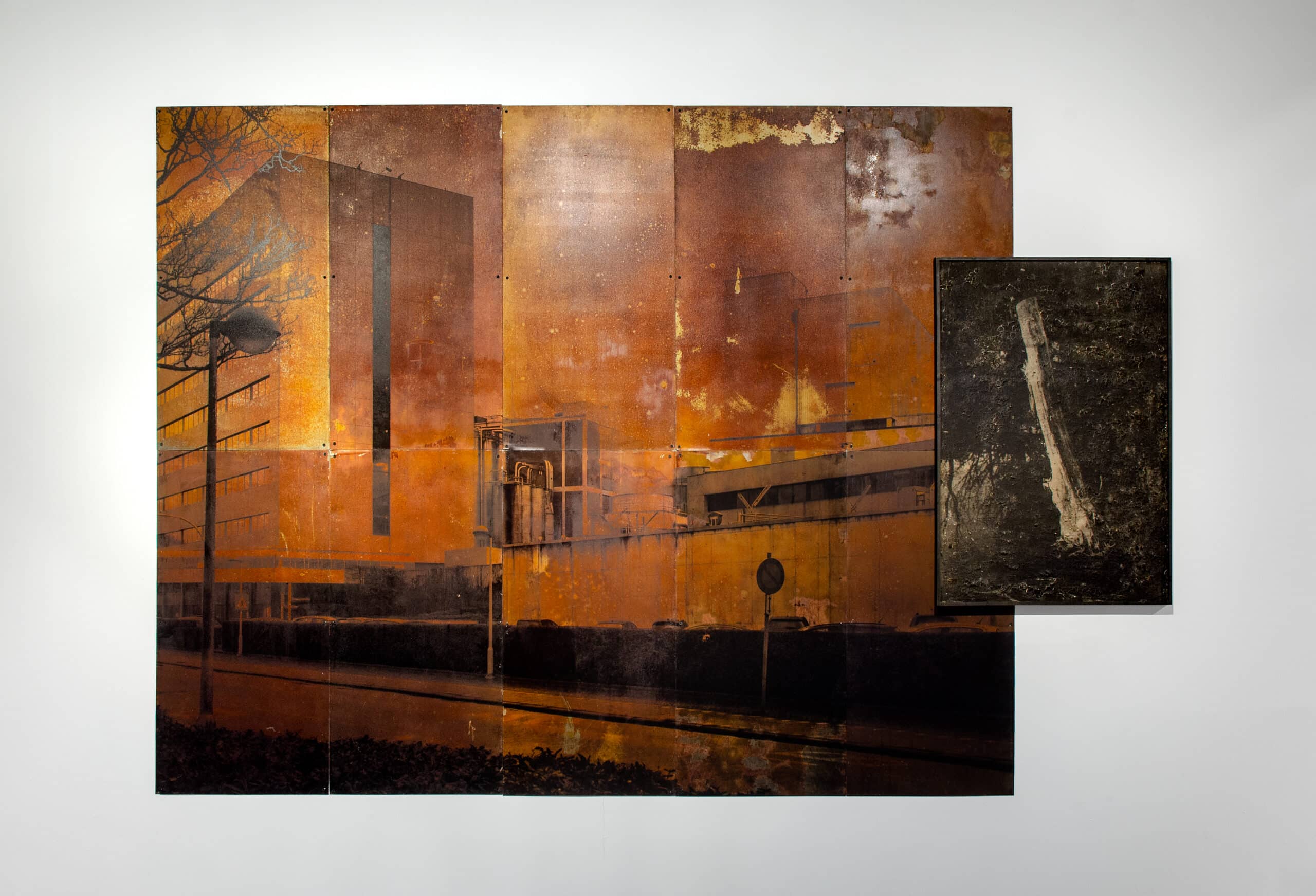
Conjuring the story of a man who turned mud into silver might be reminiscent of an alchemical myth or a children’s tale. Lucas Leffler’s Zilverbeek (Silver Creek) is however based on a true story discovered in the archives of the company Agfa-Gevaert, a manufacturer of photographic paper in Belgium. In the 1920s, one of the employees would have found a method to recover the precious metal from the wastewater poured into the nearby creek, enabling the recovery of half a ton of silver per year.
“This is the story of a man who turned mud into silver”. This sentence might be reminiscent of a children’s tale, yet Zilverbeek (Silver Creek) is based on the true story of a man working for a photographic paper factory, finding a way to recover silver from the wastewater discharged in the nearby creek.
What interests Lucas Leffler, rather than the accuracy of the facts, is the evocative power of the myth and its creative potential: would it be possible to harvest a photographic image out of the polluted mud?
The very matter that constitutes the contamination in the landscape surrounding the industry becomes the support of the image that represents it. Renegotiating the terms of his relationship with toxic waste, Lucas Leffler proposes a definition of toxicity as intrinsically linked to the photographic process itself, an inevitable fatality embedded in its own history and condition.
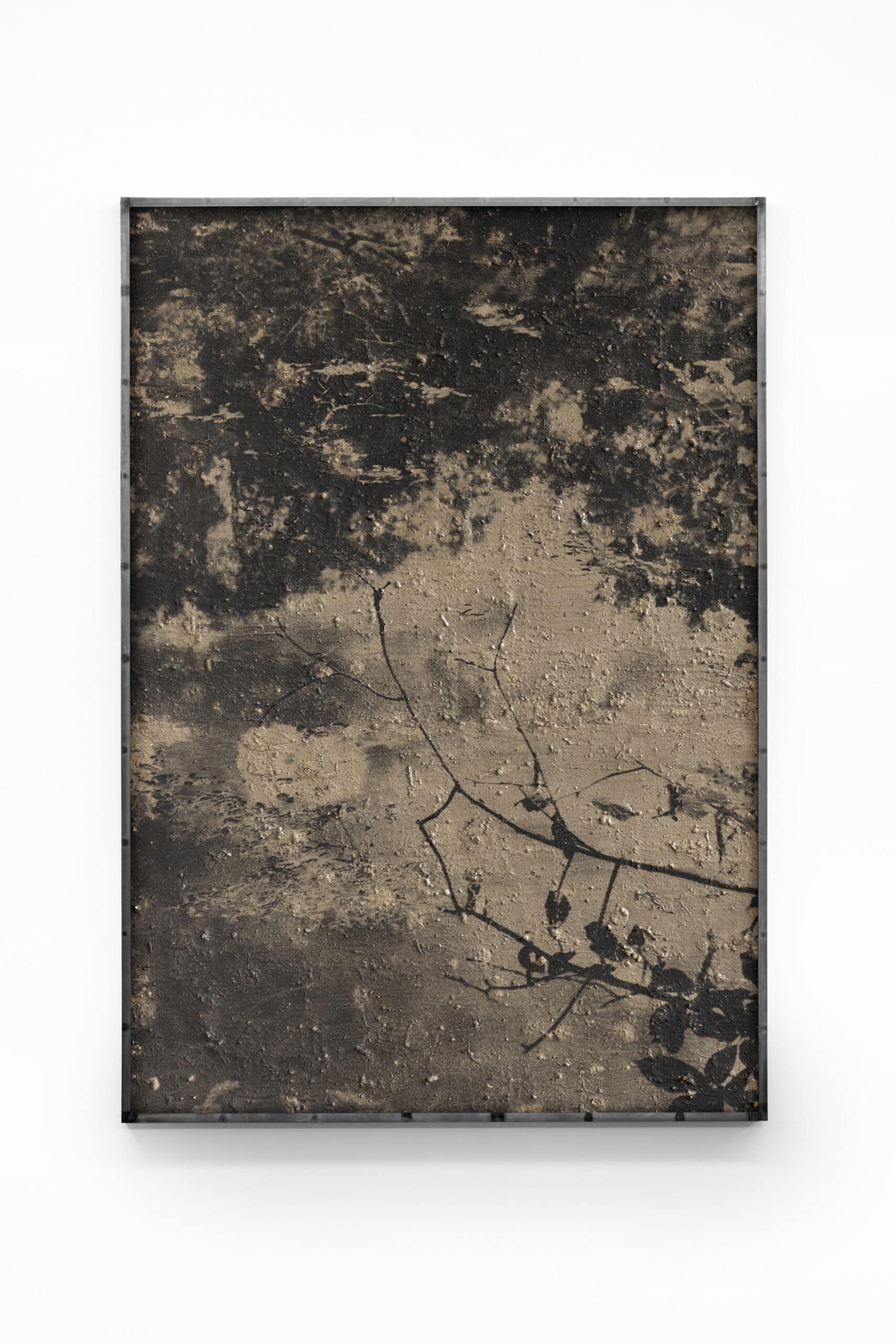
Lucas Leffler, Zilverbeek, 2017-2020. Analog prints made with a mixture of mud.
What interests Lucas Leffler, rather than the accuracy of the facts, is the evocative power of the myth. The polluted creek nearby the factory, whose existence is very well documented between the 20s and 50s, thus becomes the site of projection of an alchemical fascination: would it be possible to harvest a photographic image out of the polluted mud, impregnated with silver particles?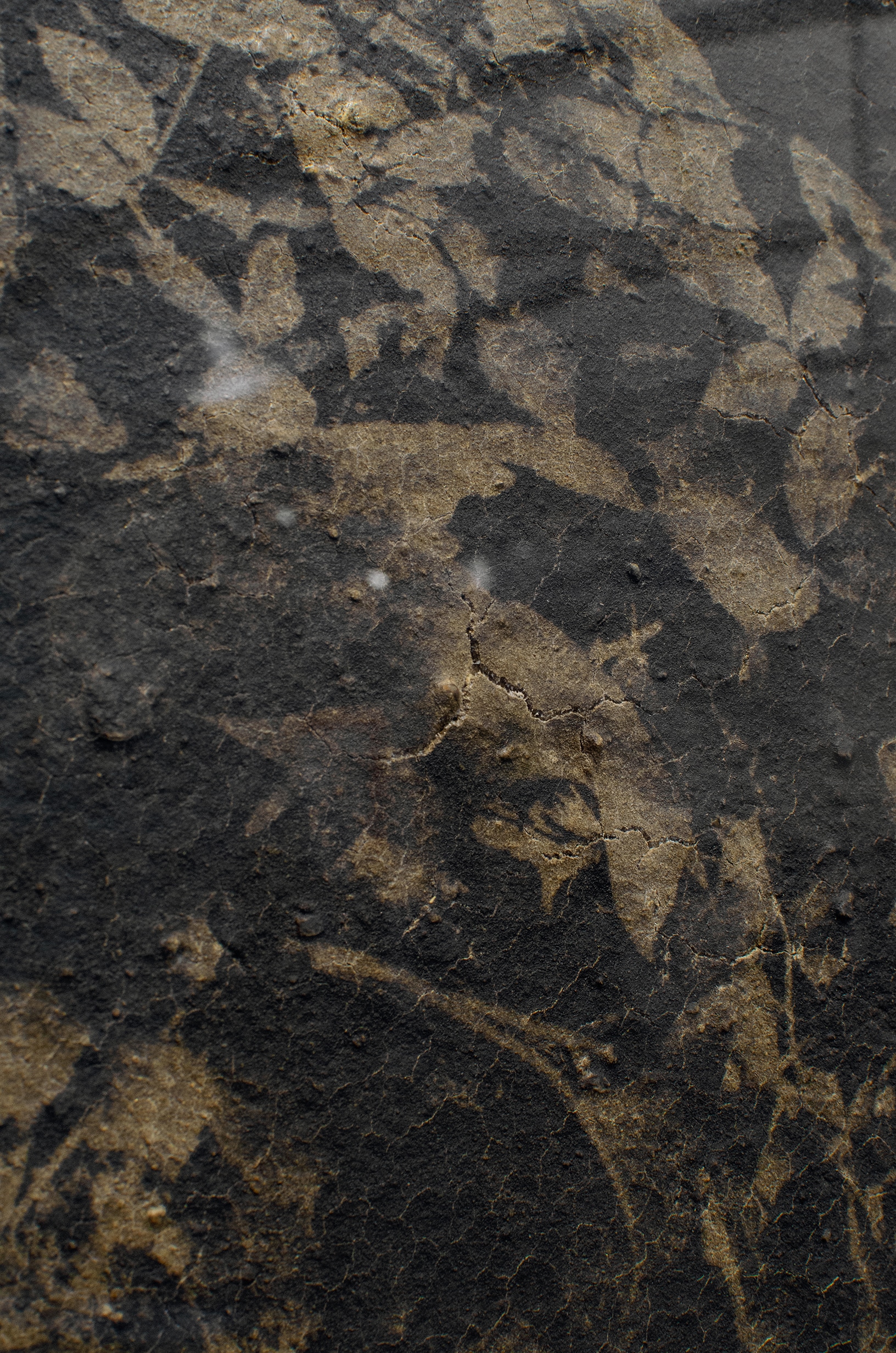
Lucas Leffler, Zilverbeek, 2017-2020.
Since the industry standards implemented by the factory after the 1950s considerably reduced the pollution of the creek, the mud is not photosensitive enough. Lucas Leffler then developed his own method, adding photosensitive chemicals to the mud collected in the stream surrounding the factory, in order to obtain a photographic print on the mud itself.
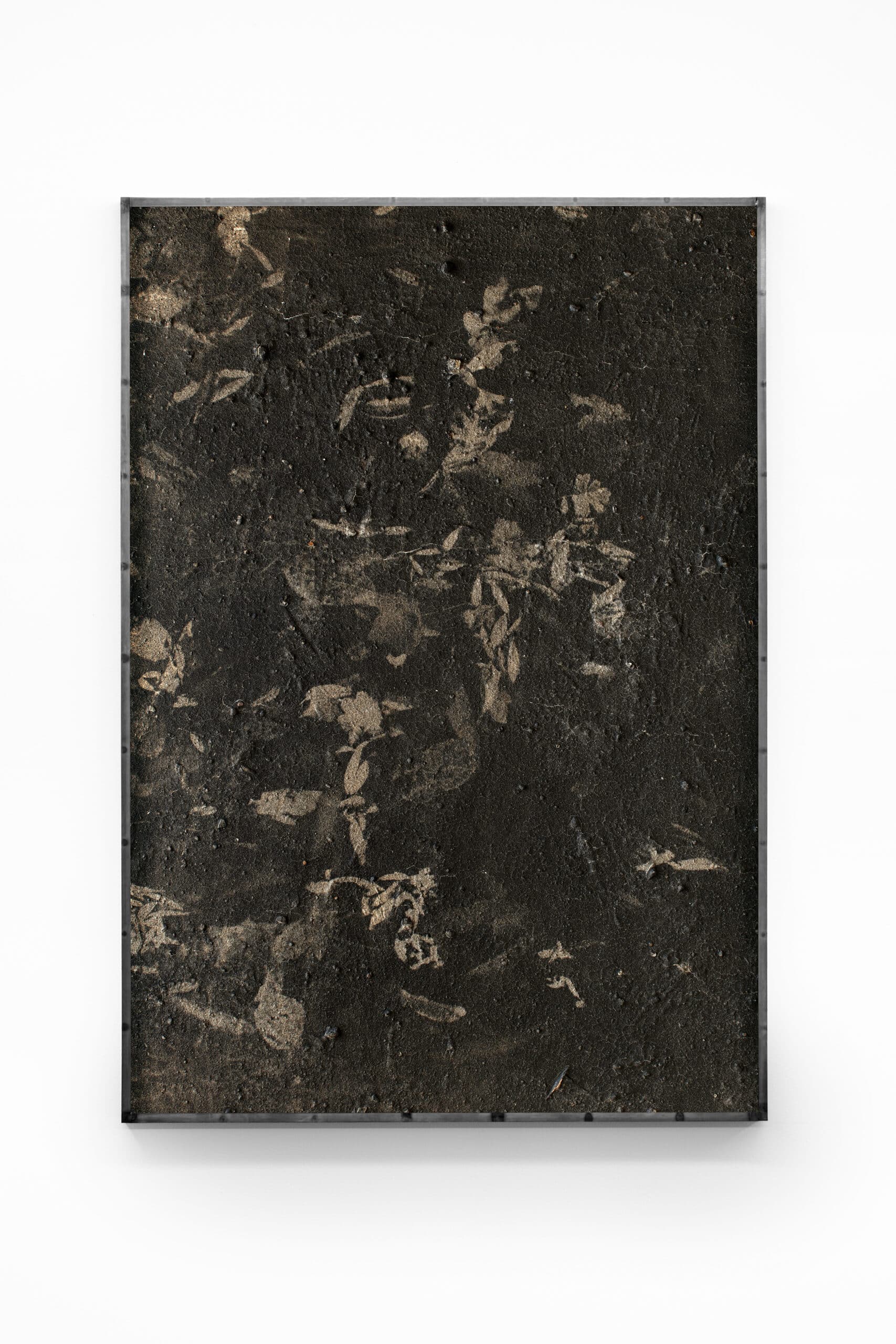
Lucas Leffler, Zilverbeek, 2017-2020.
In Zilverbeek (Silver Creek), the very matter that constitutes the toxic landscape becomes the support for the image that represents it: with views of the vegetation surrounding the factory and the creek, nowadays a sewer, whose delicate shadows are projected on the cracked surface of the mud prints.
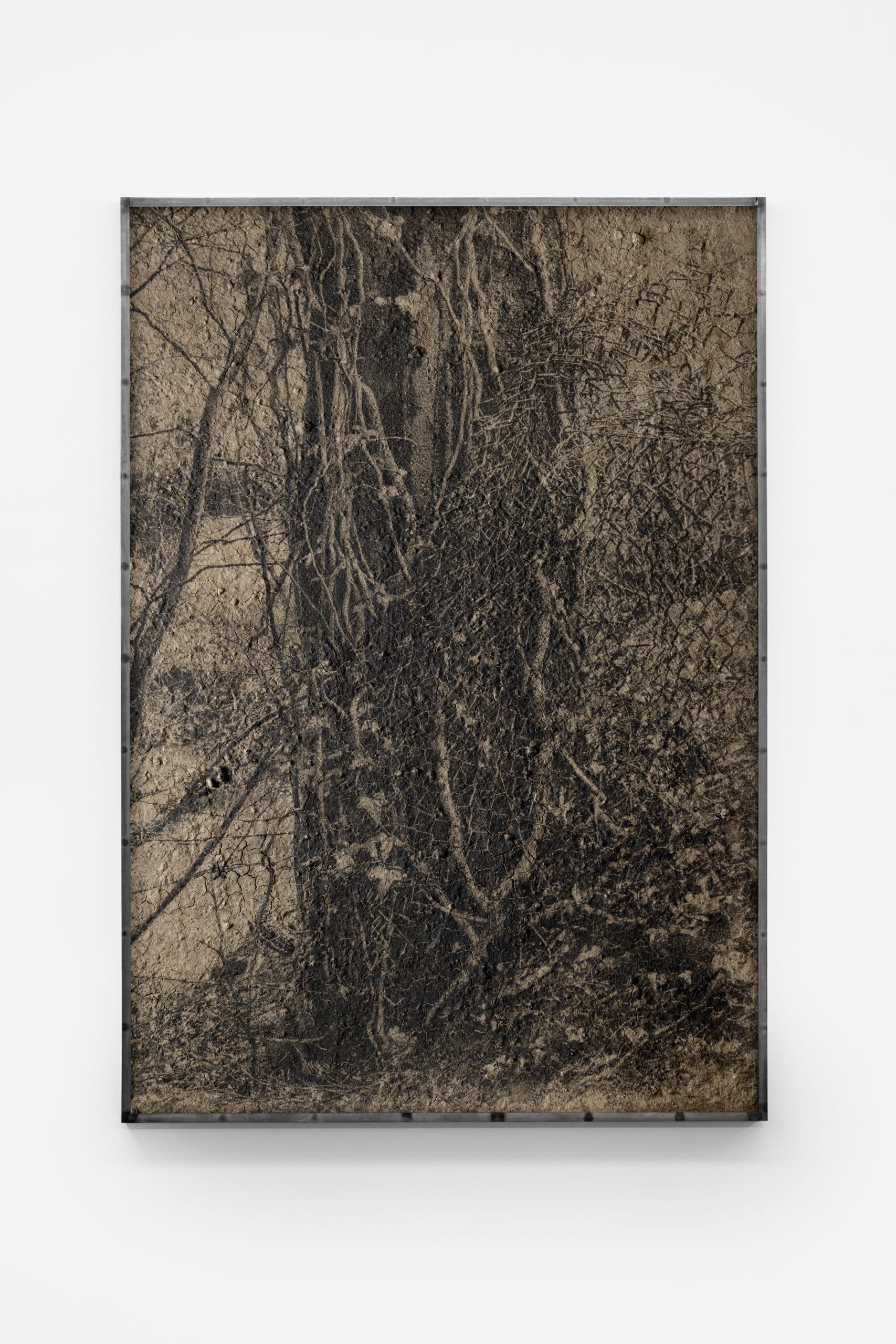
Lucas Leffler, Zilverbeek, 2017-2020.
While particularly interested in the materiality of images, that he considers a critical concern in contemporary photographic practices, for Lucas Leffler the toxicity linked to the photographic process itself – from the extraction of minerals necessary for the manufacture of lenses and sensors, to the pollution that toxic chemicals products generates, both for the environment and for the photographer - seem a fatality embedded in its history and its own condition.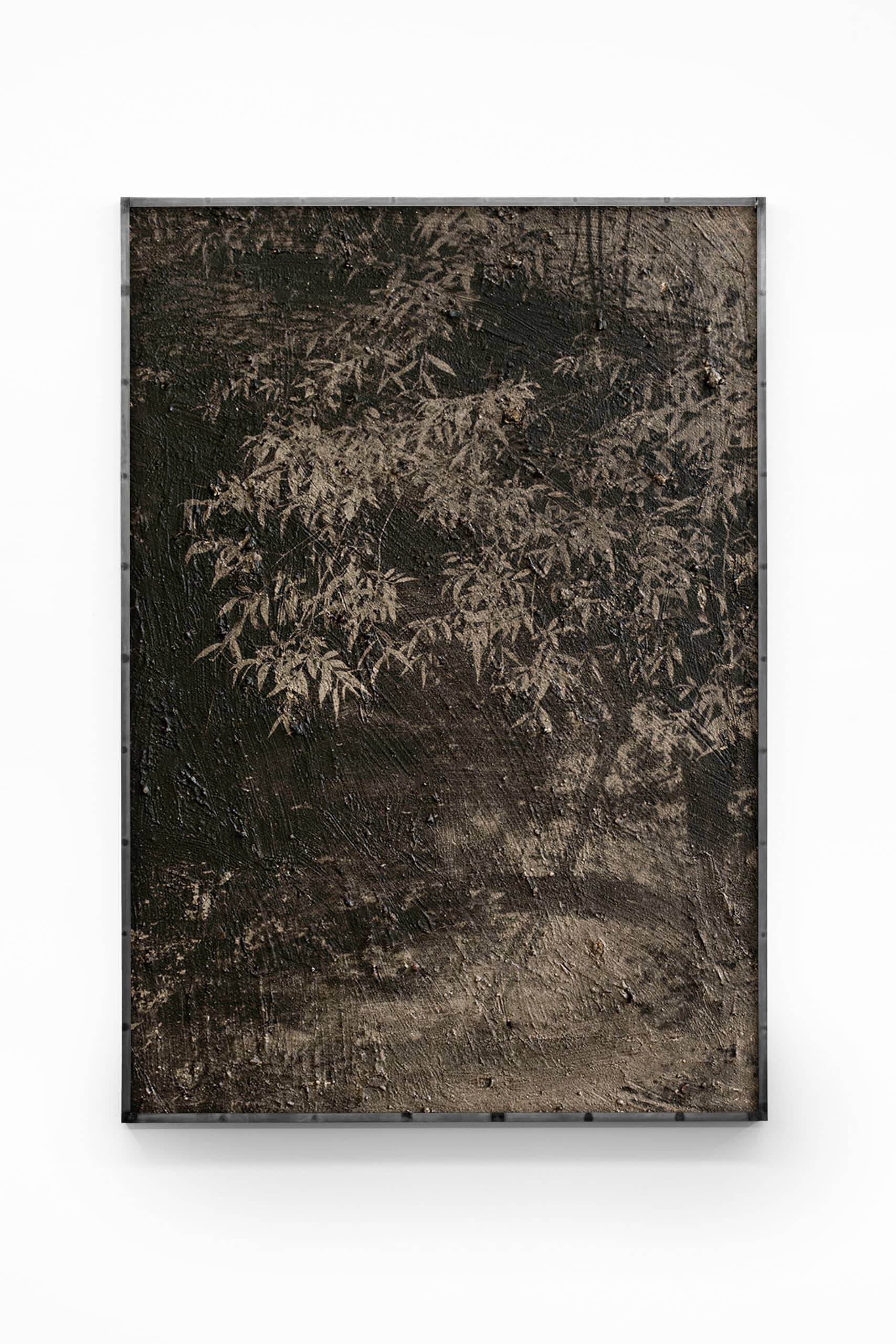
Lucas Leffler, Zilverbeek, 2017-2020.
“Photography itself is a product of the industrial world. For me, the desire to produce photographic images that are completely non-toxic for the environment is rather utopist. Perhaps toxicity is something intrinsically linked to photography, which was created by means of chemistry, which is also a product of modernity, of the industrial age.”
Transit • Kristof Vrancken
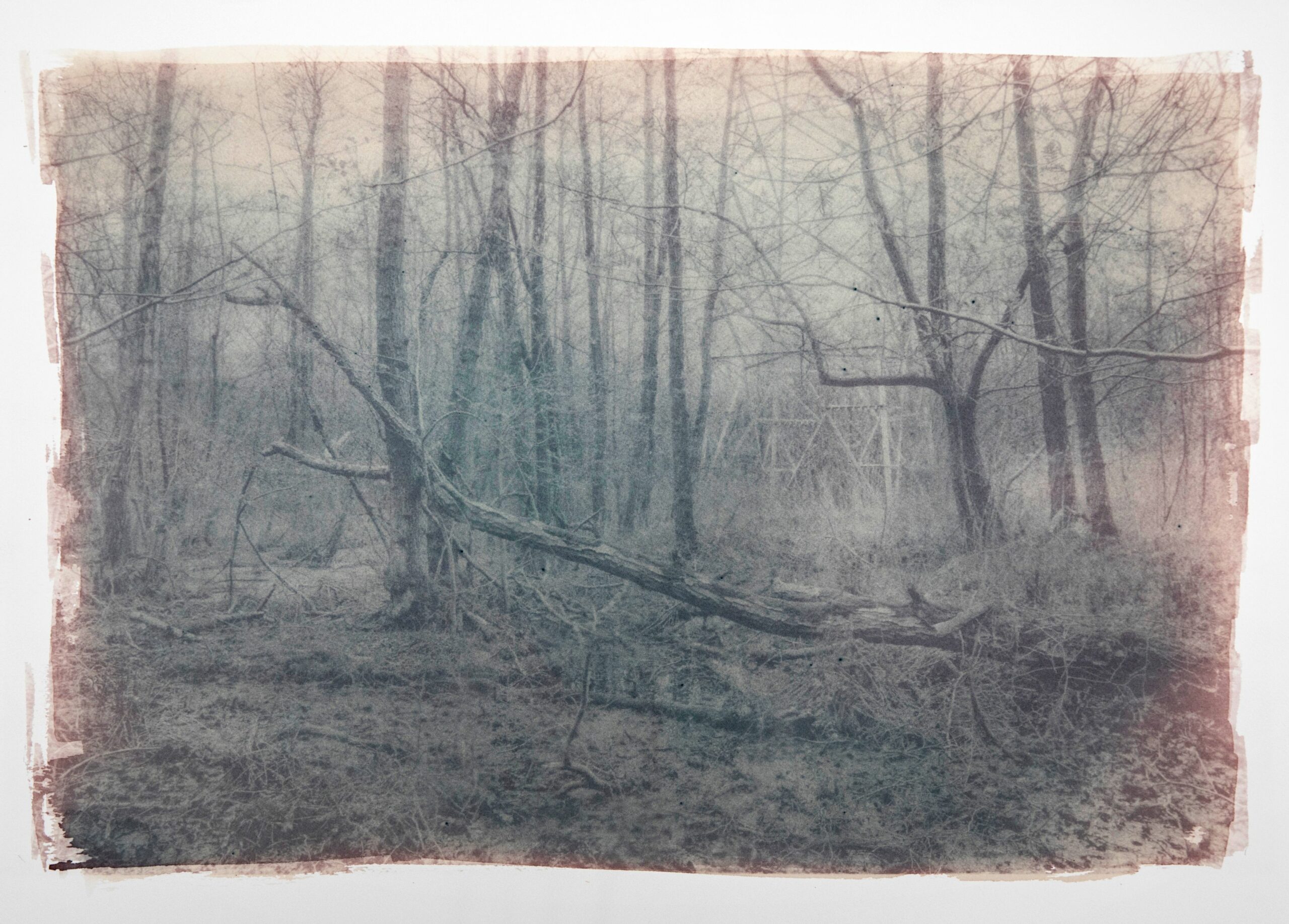
The anthotype (from the Greek “Anthos”, flower) is an ‘ancient’ process originally introduced by Sir John Hershe in 1842, in which a photographic image is obtained by exposing a photosensitive emulsion of vegetal origin to sunlight over several days or weeks. Different plants react differently to UV light, and parameters such as the freshness of the plants or the level of soil pollution might affect the final tint of the exposed image.
“This image was taken near the water source of the Stiemer Brook, in close proximity with the mining sites of Waterschei. The exploitation of the mine caused hydrogeological instability and ecological changes in the area: drainage issues have occurred due to soil subsidence, and prolonged mining operations caused a massive discharge of polluted wastewater with a heightened salt content”
[Source : Kristof Vrancken (2019) Transit, Journal of Landscape Architecture, 14:3, 34-45, DOI: 10.1080/18626033.2019.1705572]
Kristof Vrancken’s Transit investigates the entanglements between humans and non-humans inhabitants of the city of Genk: a former artists colony known for its bucolic scenery, later transformed into an important industrial center. By concocting photosensitive emulsions with contaminated plants collected on site, he produces anthotypes prints that materialize a landscape in constant evolution.
These images are living entities, materially unstable: the same light that allows the image to appear, will cause it to fade over time. Living images in order to represent a living environment, a non-static habitat characterized by impermanence, where survival implicates transformation and renegotiation of existing relationships among humans and non-humans.
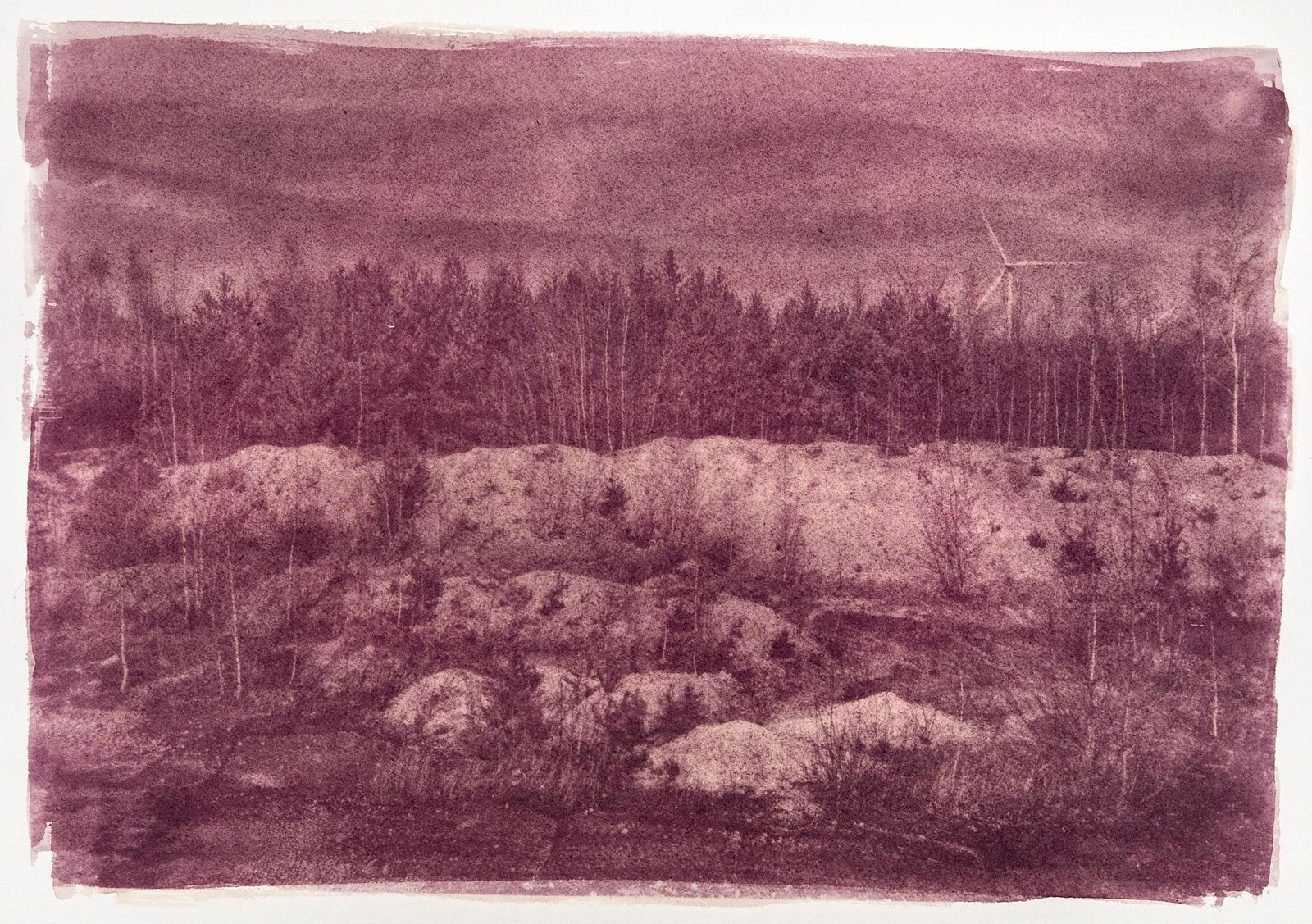
Kristof Vrancken, Waterschei, Genk, 2017. 46 x 61 cm, anthotype, blackberry emulsion on paper; exposure: 4 weeks.
In his Transit series, Kristof Vrancken focuses on the landscapes of the city of Genk, a former artistic hub known for its bucolic scenery, which later became an important industrialized center due to exploitation of the local coal mines discovered in the XX century, and the establishment of a large automobile manufacturing plant in the 60’s. The city and its surroundings have been in constant evolution since, and even today - decades after the cessation of coal mining activities, and in the aftermath of the closure of the Ford factory - Genk is dealing with the legacy of its industrial past, and its long-term environmental consequences.
“The Genk landscape changes so fast that it is almost in continuous transition: sand is extracted from one place and supplemented in another; roads are constructed to be soon deserted; woods are planted while others are wiped out; buildings are constructed on the dumping grounds of old mines. The landscape is continually managed from an economic point of view.» [Source : Kristof Vrancken (2019) Transit, Journal of Landscape Architecture, 14:3, 34-45, DOI: 10.1080/18626033.2019.1705572]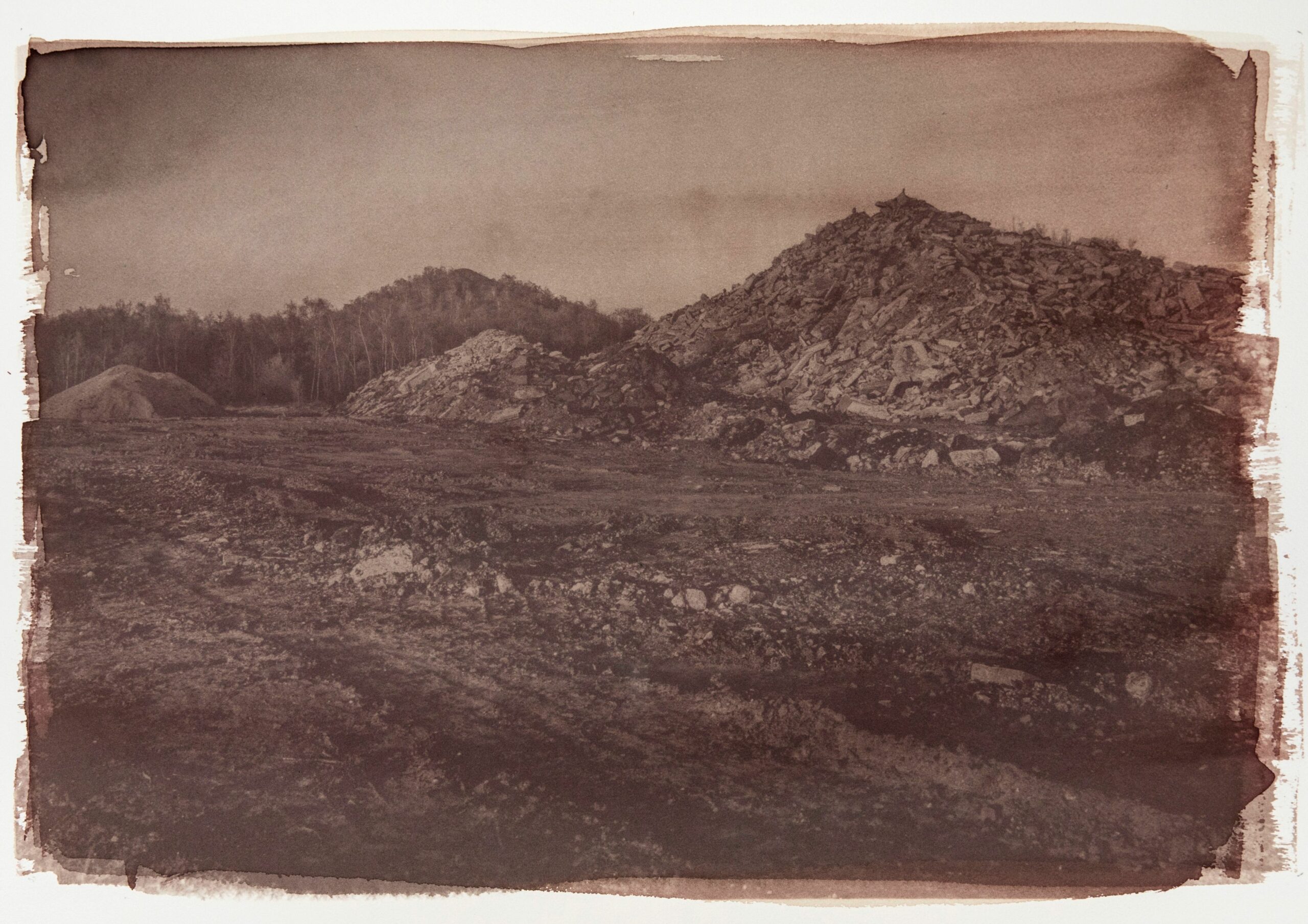
Kristof Vrancken, Zwartberg, Genk, 2017. 46 x 61 cm, anthotype, poppy emulsion on paper; exposure: 1 week.
The use of the anthotype is for Kristof Vrancken a relevant way to produce images of the Anthropocene, and to account for the entanglements between humans and non-humans in the same habitat: “One of the oldest photographic methods becomes paradoxically an appropriate tool for approaching a contemporary topic while reliving history”.
“The many black slag heaps remaining in the Genk landscape are an unmistakable mark of the Anthropocene. Dark witnesses of decades of coal mining operations, and symbols of the disruption of geological layers. Even though they are still heavily contaminated by metals, nowadays they harbor an ecosystem where some rare plant and animal species have found their habitat. Habitats are not static, but continuously in transition.” [Source : Kristof Vrancken (2019) Transit, Journal of Landscape Architecture, 14:3, 34-45, DOI: 10.1080/18626033.2019.1705572]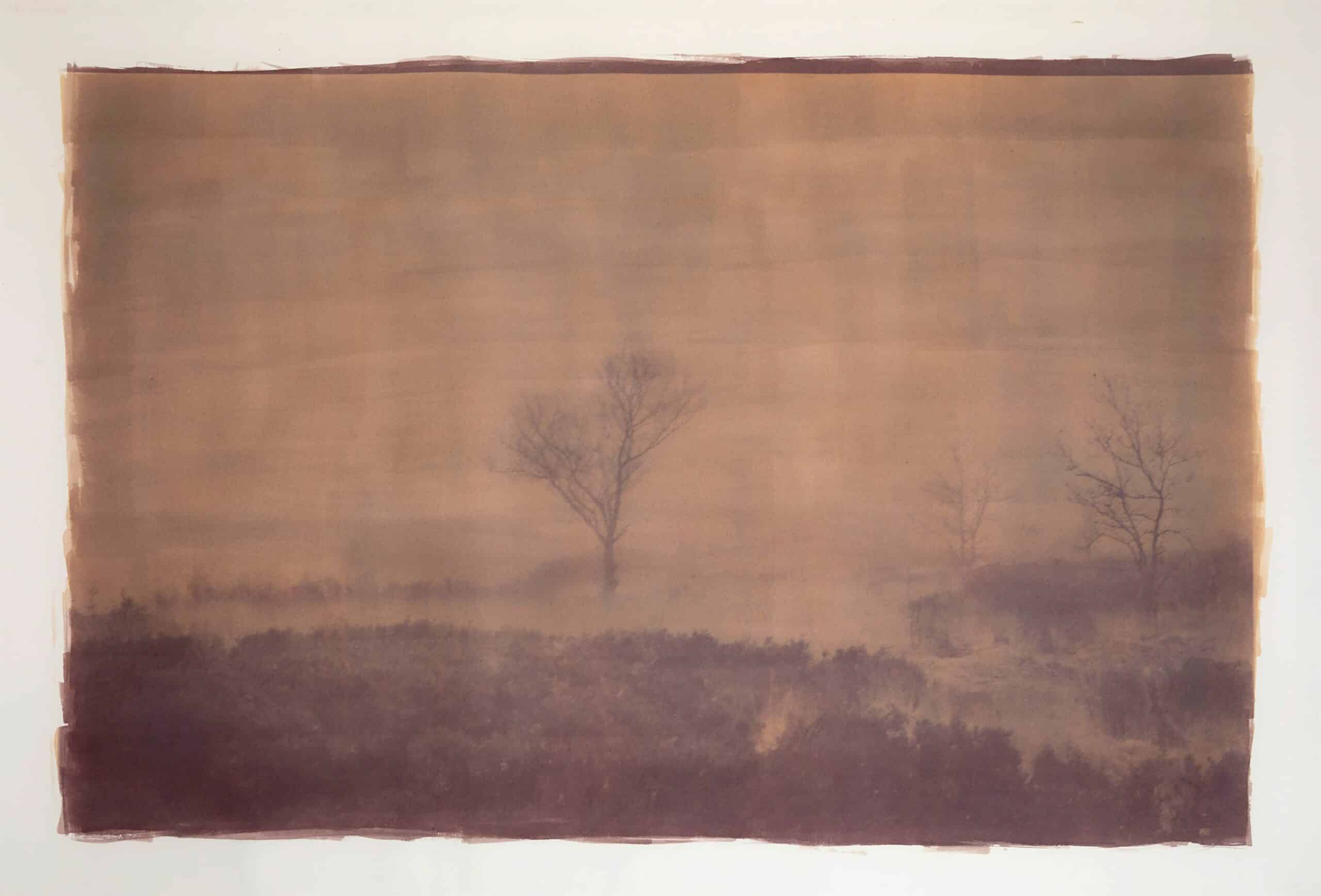
Kristof Vrancken, De Maten, Genk, 2017. 88 x 138 cm, anthotype, black cherry emulsion on paper; exposure: 7 weeks
Kristof Vrancken’s anthotypes prints not only represent the landscape, but materializes it from decoctions of plants that he harvested himself on the same sites where the photographs were taken, striving to ensure that every material used in the process is as local as possible, right down to the alcohol used for the emulsion (jenever, a local gin distilled from juniper berries).
“This print was made with an emulsion of Prunus serotina or black cherry. This is an invasive plant that thrives on acidic, sandy and poor soil with lots of sunshine, as is the case in the fallow lands of Genk. At the moment, it is almost impossible to contain the spreading of black cherry in these areas and the native biodiversity is under severe pressure from this invasive species. Ironically, black cherry was extensively planted across Europe around 1915 as fire protection and to fill up dry and monoculture pine woods for economic reasons and the mining industry. The bark and leaves of black cherry trees produce a toxic cyanide that prevents native insects from finding a habitat. Woods that are primarily composed of these trees have a large negative ecological impact.”[Source : Kristof Vrancken (2019) Transit, Journal of Landscape Architecture, 14:3, 34-45, DOI: 10.1080/18626033.2019.1705572]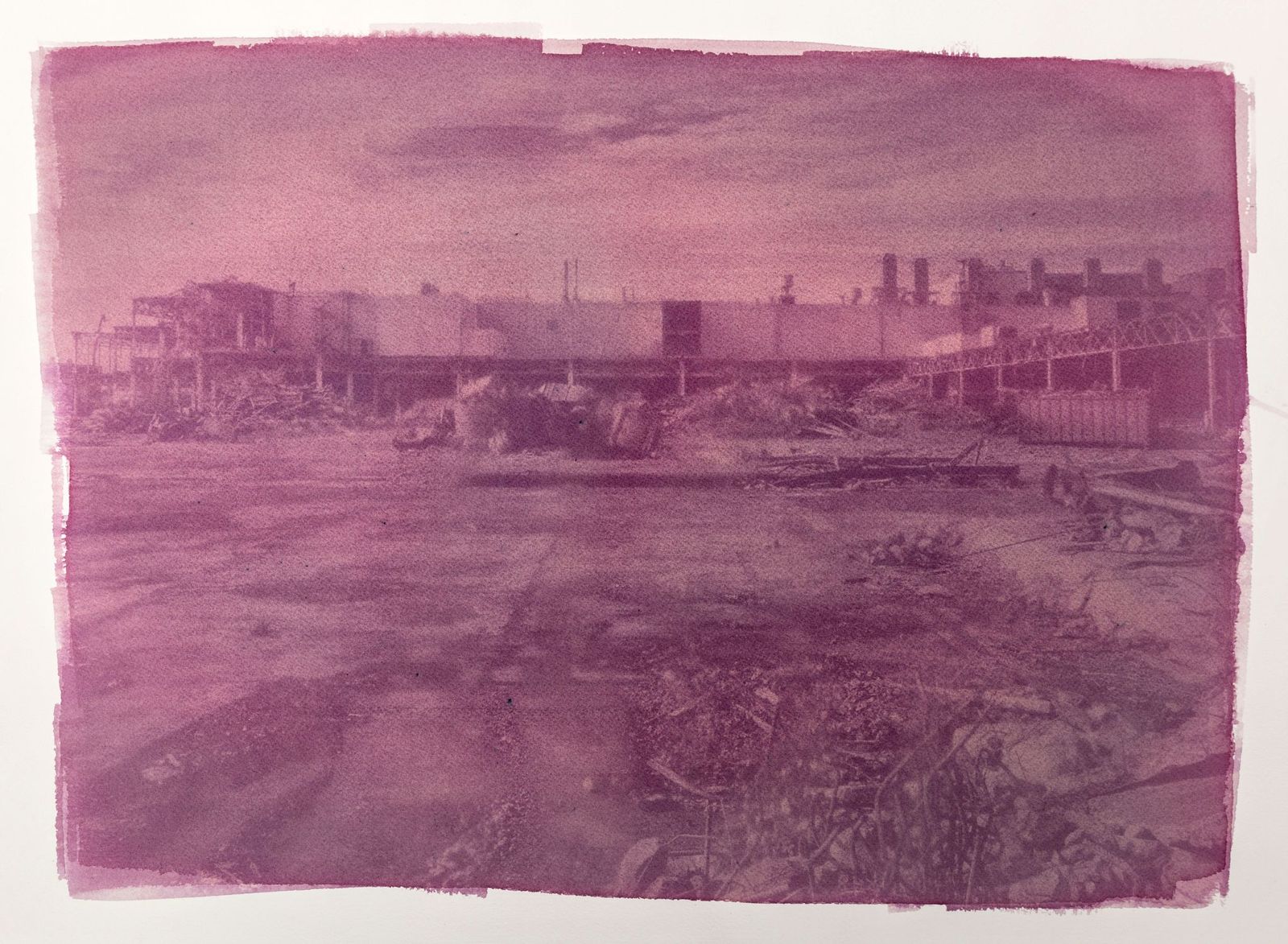
Kristof Vrancken, Genk South, Genk, 2017. 46 x 61 cm, anthotype, elderberry- blackthorn emulsion on paper; exposure: 4 weeks.
The plant species used to realize the photosensitive emulsion change according to the rhythm of the seasons, and are also bio-indicators of the quality of the soil in which they grow. The resulting anthotype prints materially carry the landscape they represent, encapsulating the soil pollution on the sensitive surfaces of the living image.
“The Ford factory in Genk closed in 2014 and the demolition of the site followed in 2017. This image was printed with a drinkable emulsion of gin, elderberries and blackthorn berries that were harvested at this strongly polluted site. The berries can contain increased levels of nickel, chrome, manganese and zinc, but the potion itself tastes deliciously sweet since these metallic traces are odourless and tasteless. Consciously drinking this toxic emulsion makes you an active bearer of the Anthropocene. The elixir reveals things we don’t see, and possibly don’t want to see.” [Source : Kristof Vrancken (2019) Transit, Journal of Landscape Architecture, 14:3, 34-45, DOI: 10.1080/18626033.2019.1705572]
Kristof Vrancken, Genk South, Genk, 2017. 46 x 61 cm, anthotype, black cherry emulsion on paper; exposure: 5 weeks.
Through their manufacturing process, these images acquire a slow temporality, akin to the one of vegetal life, and totally disconnected from the instant-snapshot typical of digital photography. Images as a labor of time (the one spent harvesting the plants, waiting for new species to appear in the following season; the length of exposure to sunlight; even the life expectancy of the print itself, destined to inevitably fade over time ) and mirrors of a landscape in constant evolution.
“Tons of sand were shipped in the region of southern Genk to prepare the marshy subsoil for the construction of a new industrial zone. The massive dump of sea sand submerged the existing flora and the birch trees that remained standing died within the following year. The closest sea is more than 200 km away, but nevertheless one can
now find tons of seashells in this area. During the summer of 2019, ironically, a temporary beach bar was installed.” [Source : Kristof Vrancken (2019) Transit, Journal of Landscape Architecture, 14:3, 34-45, DOI: 10.1080/18626033.2019.1705572]
Eating Magma • Elena Aya Bundurakis
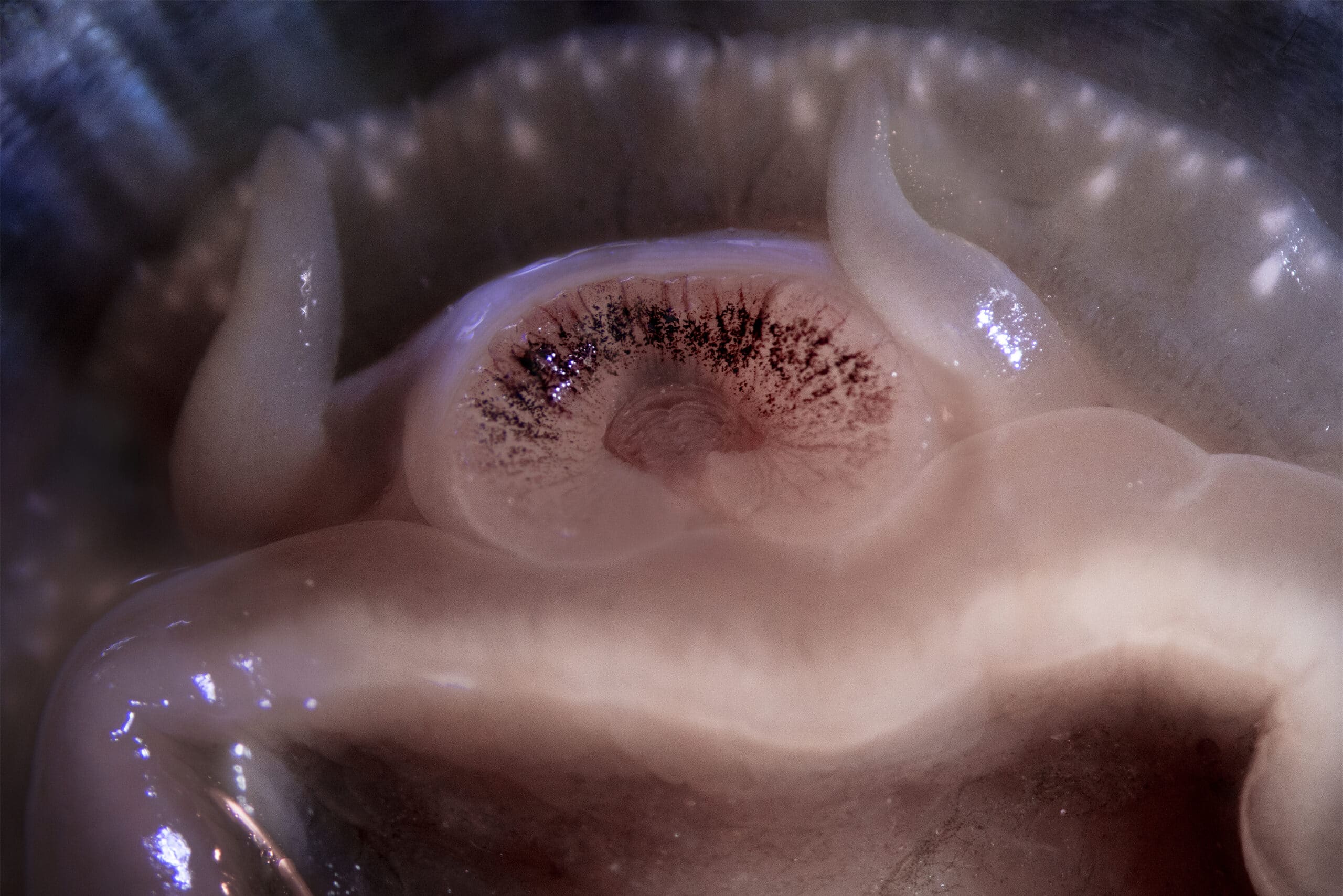
Look all over.
Extract and alter the natural elements that surround you in the constructed reality.
Eat some Magma.
Nature (primal / modern / post nature) is always imbued with mystery.
Nature mutates herself and is being mutated.
She is the Queen and the Underdog.
It is about basal instincts and existence.
Some animals of the now exist already for millions of years.
Ancient is alive.
Ancient is more cyborg than cyborg.
200 million years old animals will survive the post nature.
New ways of life. New ways of die.
It is about breathing.
Eat and smell and touch.
I will look into 4 Fs: my Flesh, my Food, Fauna and Flora.
Learning about less imagined versions of the surrounding world.
Embody the natural, emotional and ethical crisis.
How does it feel to have a flesh and be a vertebrate?
The work of Elena Aya Bundurakis employs the hybridization of natural and artificial elements, visually merging in a non-hierarchical way, to offer a sensory approach to understanding the living.
Using the camera as an hungry haptic device rather than an optical one, and combining photographs, drawings and haikus – which she defines as snapshots in words – Eating magma aims to sense what it means to be alive today, to coexist with
the toxicity within us, and in the world that surrounds us.
For Elena Aya Bundurakis the concept of toxicity is omnipresent and mutable, it can take forms as diverse as “preschools trying to teach children the alphabet, contaminated soils, the monetization of water, extravagant rents for unsanitary apartments, the ignorance and mockery of others”. This toxicity affects every relationship in our interconnected universe and forces us to assume shifting identities, to contaminate each other, and sensually cooperate in order to sense new
ethical positions within our environment.
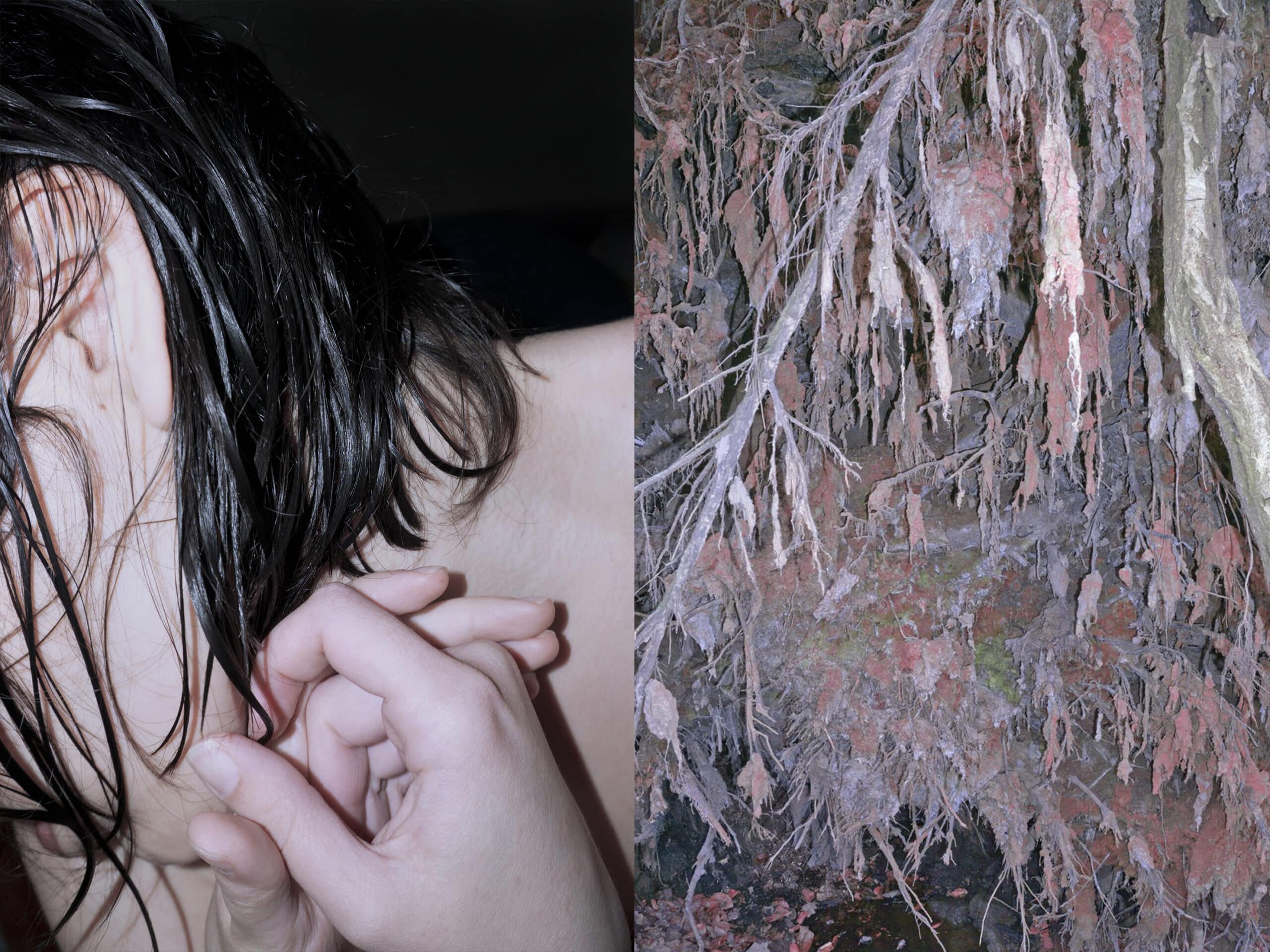
Elena Aya Bundurakis, Eating Magma, Dermaden, Magma Tree, 2017 – ongoing. Photographs, archival matter, drawings, video, haikus, artist book. 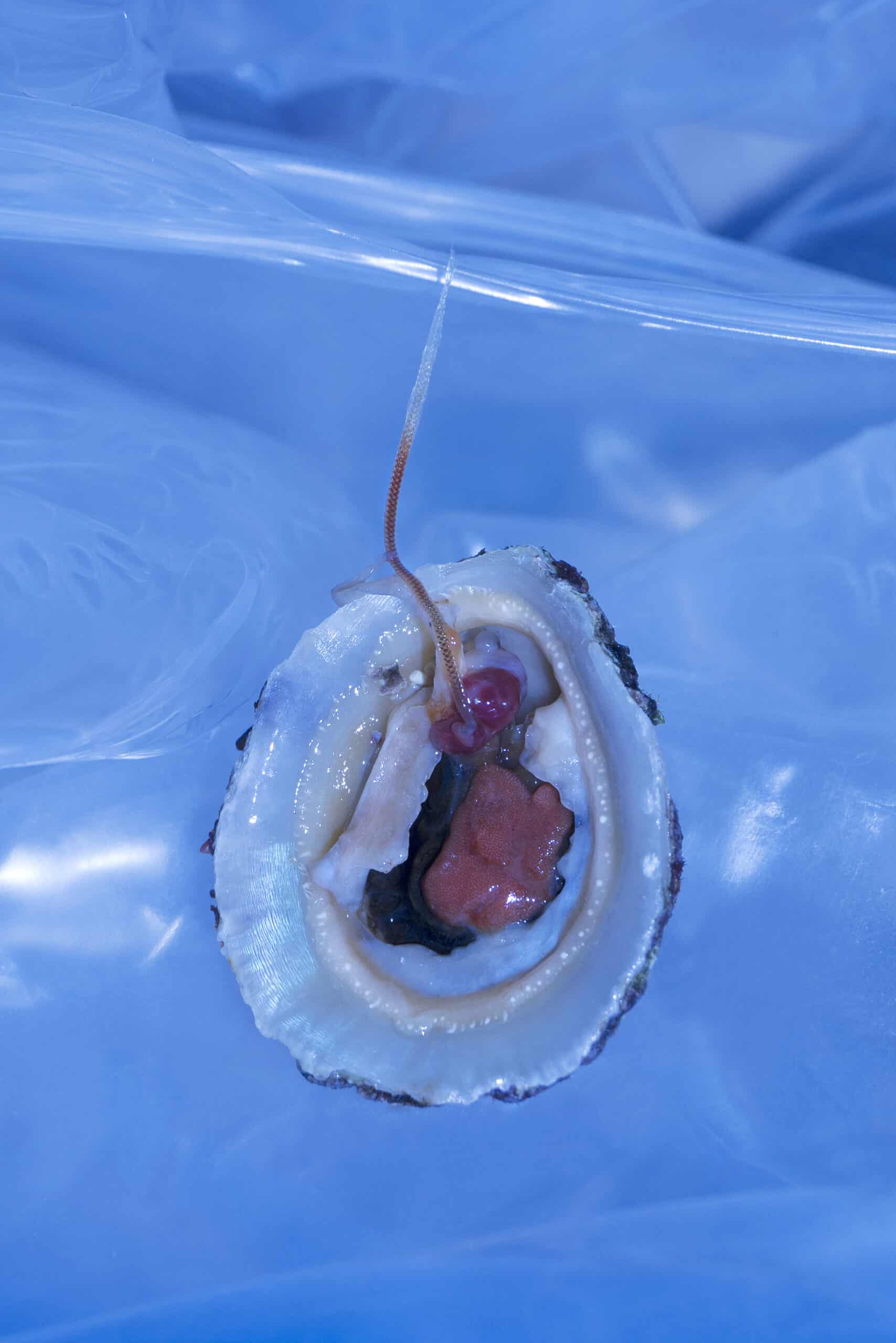
Elena Aya Bundurakis, Eating Magma, Soft Anatomy, 2017 – ongoing. 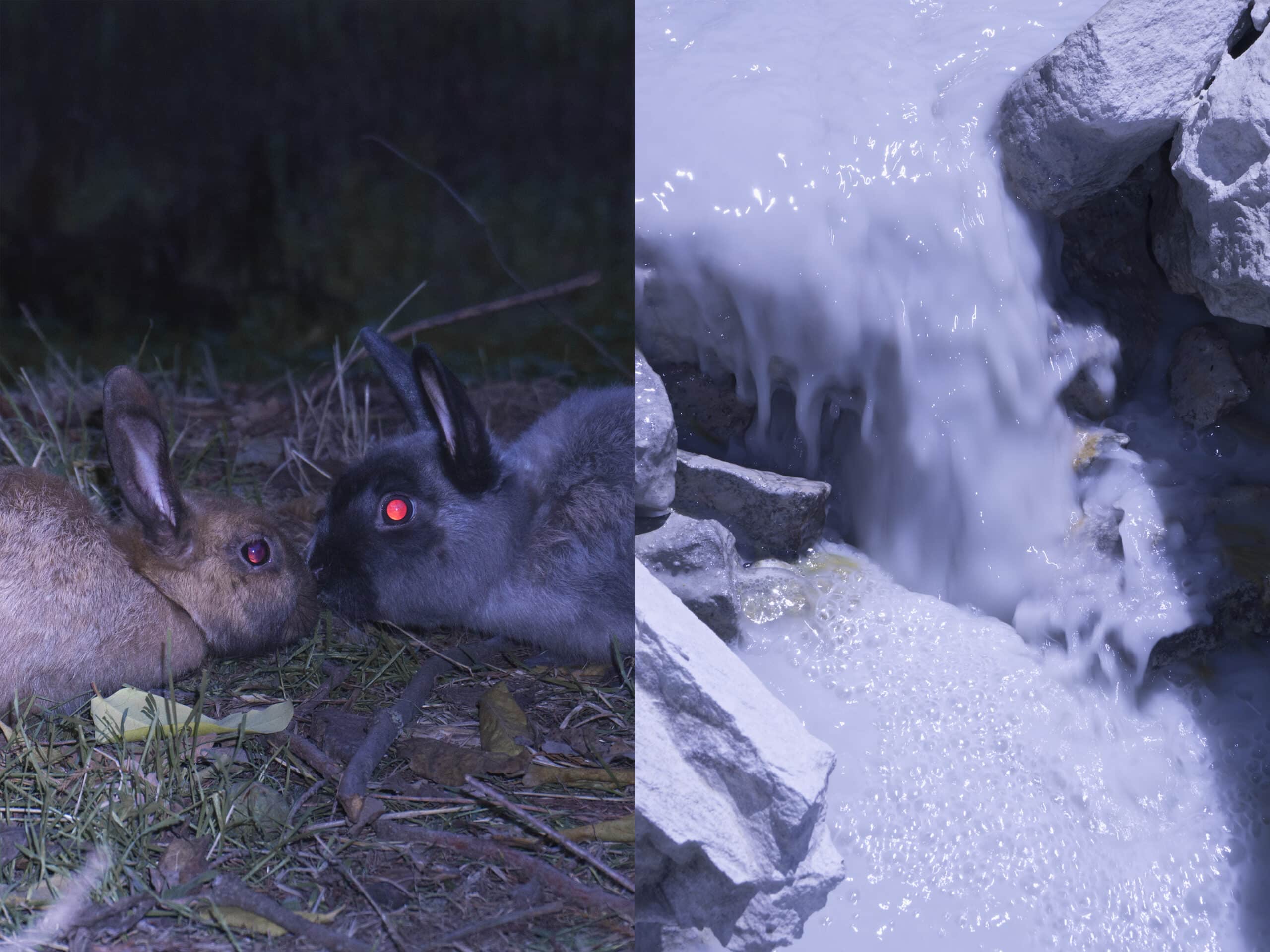
Elena Aya Bundurakis, Eating Magma, Bunny Kiss, Crystal Grey, 2017 – ongoing. 
Elena Aya Bundurakis, Eating Magma, Feeding Fish, 2017 – ongoing. 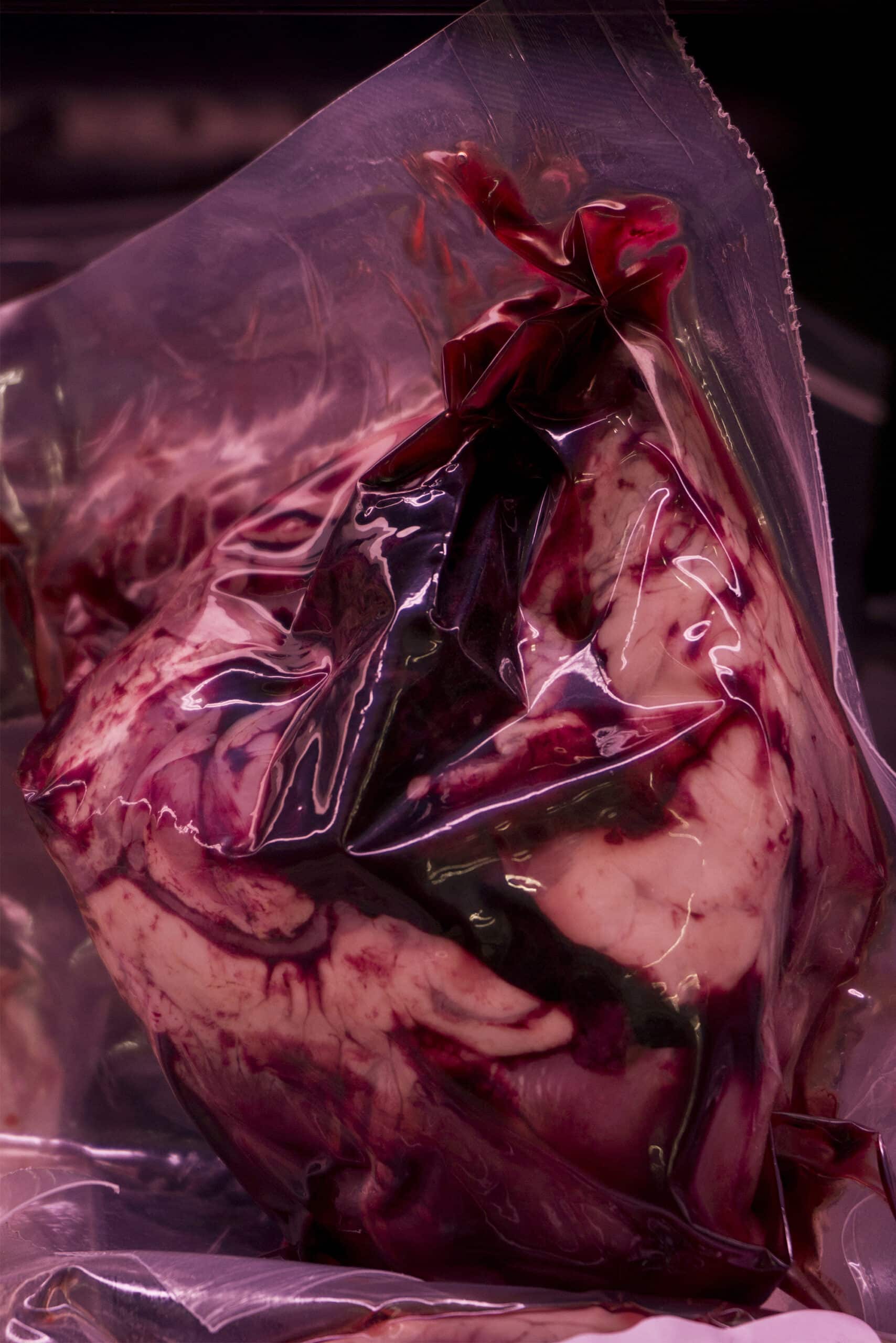
Elena Aya Bundurakis, Eating Magma, Heart, 2017 – ongoing. 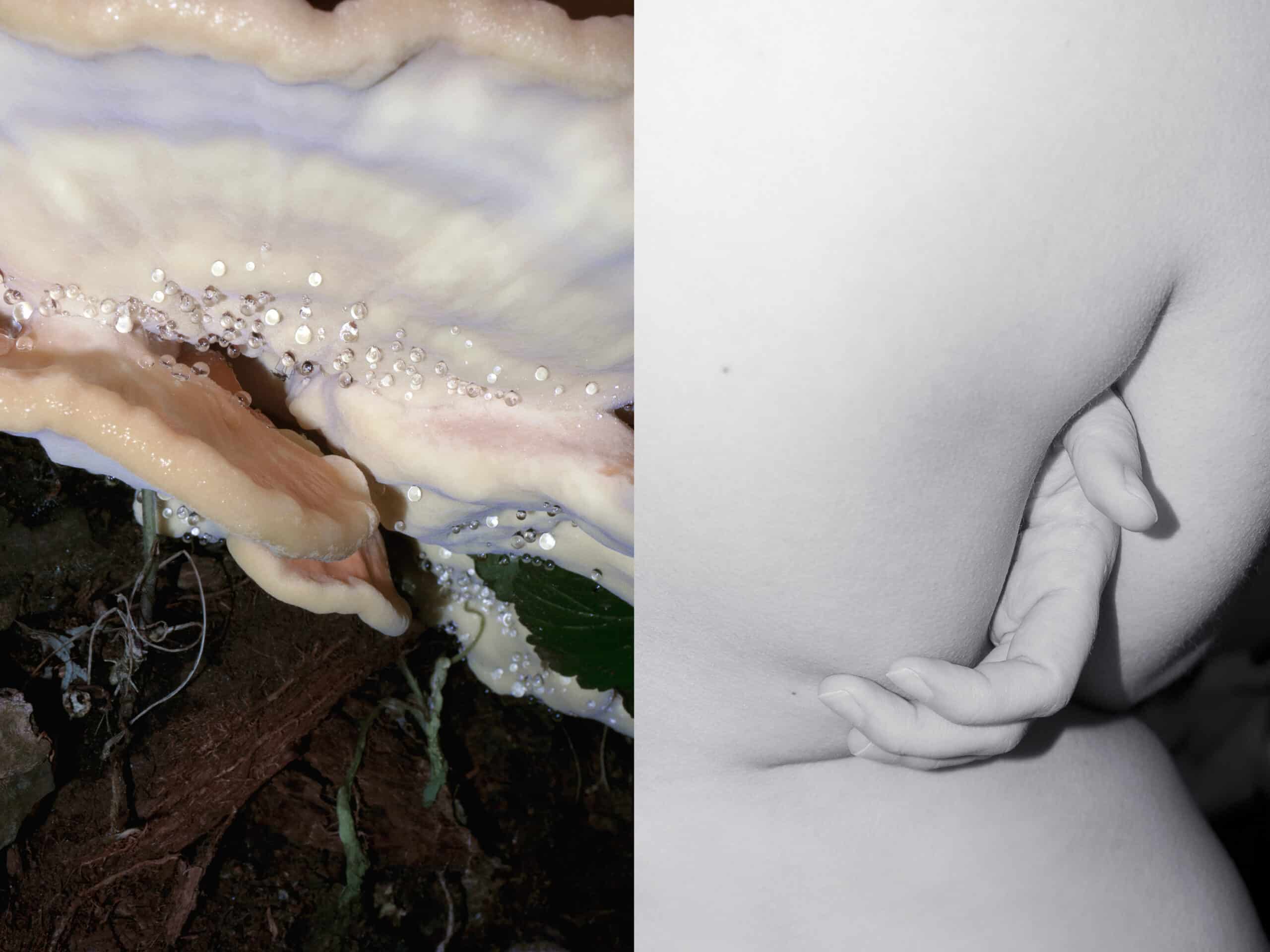
Elena Aya Bundurakis, Eating Magma, Stratum, Phalanges, 2017 – ongoing.
A Visual essay curated by moss collective, 2022.
